#i spent less than $120 total for the whole entire thing
Explore tagged Tumblr posts
Text
i recently went to see arctic monkeys at zepp haneda :D here's some pics i took and edited just a little<3 pls rb & like if u use them or anything










#i am actually an insane am stan#i hope it was obvious the moment i posted that alex piece#alex turner#arctic monkeys#i am in so much physical pain rn bc the crush was crazy but it was worth it#i spent less than $120 total for the whole entire thing#merch transpo food tickets etc#it was awesome i totally lucked out
27 notes
·
View notes
Text
Krenko’s Guide to Pokemon: Mr. Line
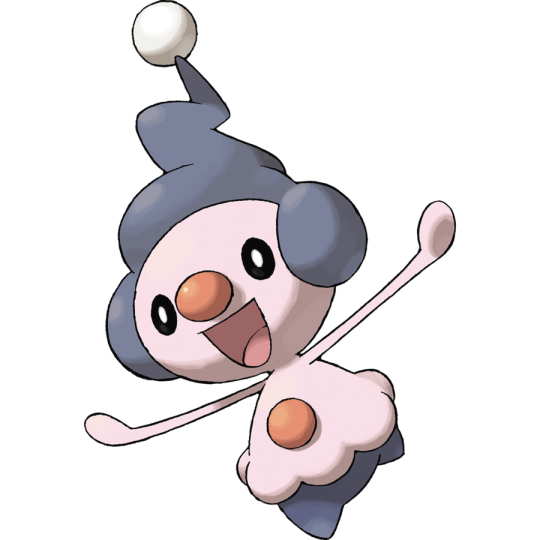
“If a tree falls in the woods, and nobody is around to hear it, and it hits a mime, does anyone care?” ~ Gary Larson
DESIGN
Mime Jr.’s actually pretty cute, looking like a tiny little silly clown. The design is a bit generic but also very effective, making it a creature with just enough clown parts so that you know it’s a clown without so many clown parts to look terrifying. It also manages to look a lot like one of those clown-faced ice creams you can get at some places, where the cone is upside down as a hat. The point is, Mime Jr. is a small, cute pokemon that works perfectly fine.
Next is “Kantonian” Mr. Mime, and I put that in quotes because this Pokemon isn’t actually Kantonian. As with Farfetch’d, Mr. Mime is called Kantonian because that’s the first region we as players could get it, but the only ones available in Kanto outside of Let’s Go are either from trades or from the game counter, plus a very tiny amount that appear in the grass patch south of Pallet Town in Gold and Silver but not Red and Blue, implying that someone in Pallet Town has been breeding and releasing Mr. Mimes, and I’m not going to say who, but we all know these Mimes are a certain protagonist’s half-siblings, don’t we?

So where is Mr. Mime from? Well, we’ve established that the first Mr. Mime we met, Marcel, didn’t come from Kanto, and there’s no Mr. Mime in Johto, Hoenn, or Unova. Alola’s a weird one, as they don’t appear in Sun and Moon but they do appear in both Ultra Sun and Ultra Moon. Still, they’re only in one location and Alola is known for having many imported Pokemon. Sinnoh’s a possibility- while the Trophy Garden is clearly cultivated, Mr. Mime and Mime Jr. both appear in the wild in Diamond (but not Pearl). Still, I think the actual natural habitat of this Mr. Mime is the Reflection Cave in Kalos. Not only would a mime Pokemon make the most sense in the Kalos region, but it’d make far more sense for it to be living in a hall of mirrors than simply wandering grasslands as it does in Diamond. Further, this is in much closer proximity to the Galar Region, where Mime Jr.s and Galarian Mr. Mimes wander freely. Thus, for the rest of this article I’m going to refer to this creature as Kalosian Mr. Mime.
And Kalosian Mr. Mime is terrifying. This thing is so Uncanny Valley that it goes down to becoming some sort of Uncanny Trench where light vanishes and there’s no hope for escape. It has all the most terrifying aspects of a clown, with a vaguely human form that isn’t quite right, hair that resembles horns, and an uncomfortably close relationship with your mother. Its bright coloration and curly feet are just sort of haunting, giving the illusion that it’s wearing clothes while in actuality that’s all just part of it’s horrible, horrible body.
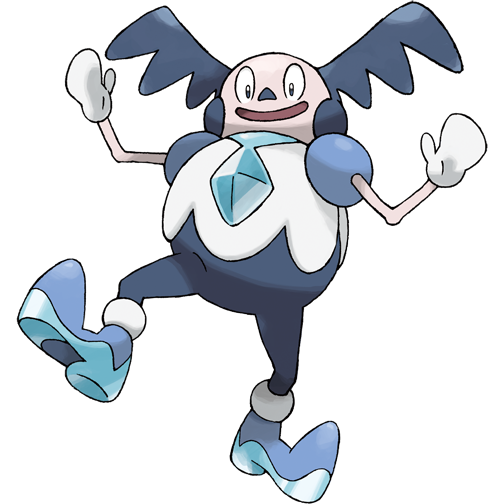
In contrast, Galarian Mr. Mime is much friendlier looking. The pants help a lot, but so do the big gloves and the nose. It looks less like a monster and more like a cartoony man, and while it’s still weird to see a Pokemon that’s so humanlike, this version doesn’t feel inherently wrong and unsettling. Much better design here, unless the goal is to freak people out. That said, I just don’t buy this as an evolved form of Mime Jr. Galar really needed a Galarian Mime Jr. to finish the set, because as is Mime Jr. turning into Galarian form in Galar and Kalosian form anywhere else just feels off. The other weird thing is that Galarian Mr. Mime, with its new focus on tapdance, doesn’t still feel like it should be called Mr. Mime. It’s something I complain about a lot with alternate forms, but if a creature’s called Mr. Mime it should be miming, not dancing, and if a creature’s called Sandshrew it should be sand based.
Visually, I love Mr. Rime. He’s got all the charm of Galarian Mr. Mime but now has a silly hat and an ice cane. He also gets the red bubble on his stomach back from being a Mime Jr. which makes me question why Galarian Mr. Mime doesn’t have it. Mime Jr. links fine to Mr. Rime, but through features lost along the way, like its hat and its big red poofs. Mr. Rime is also clearly Charlie Chaplin, and I love the pun of its name in that it’s both Rime and Rhyme.
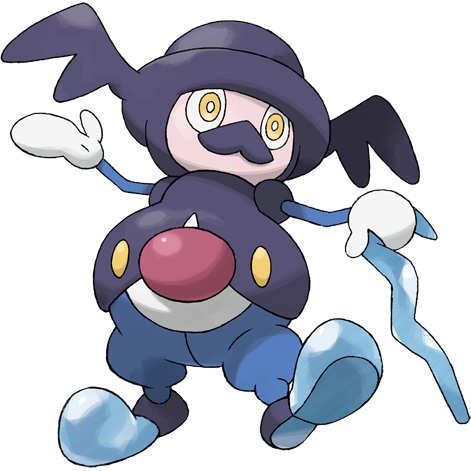
EVOLUTIONS:
Oh god this line is a mess.
First we get Mime Jr, which has first form starter stats, but evolves when knowing the move Mimic. With no TM or TR, Mime Jr. learns Mimic at 32, finally evolving into a Pokemon whose stat total is still a bit small for a final form. If it’s not in Galar, it stays a Psychic/Fairy type. If it is in Galar, it becomes a Psychic/Ice type, which then evolves again at 42 into something that’s not actually that big a boost over its previous for, making Galarian Mr. Mime a good user of the Eviolite.
And then Mime Jr. is an incense baby, so if you breed two Mr. Mimes (and you can because despite the name half are female) you get a Mr. Mime if you’re not using incense. This is a stupid mechanic that they need to get rid of.
As with Farfetch’d, the fact that the original doesn’t get a new evolution while the regional form does bothers me, because it doesn’t do anything to bring the original back into playability, it just gives us a new different Pokemon that makes the original less relevant.
I will say Mime Jr. was a good addition. While some baby Pokemon are a waste of time, Mime Jr.’s actually a really solid early-game Pokemon, and Mr. Mime’s strong enough that it shouldn’t be appearing until mid to late game anyway. Adding Mime Jr. adds a lot of playability to this line in PVE.

Art by Zerochan923600
TYPING:
Kalosian Mr. Mime spent a lot of time as a Psychic type until we actually went to Kalos and found out it was a Psychic/Fairy type this whole time. Defensively, this is decent. It only has three weaknesses, and while it only has three ‘resistances,’ one of them’s a double and one of them’s an immunity. Offensively, it’s super-effective against four types and neither type works well against Steel… but that’s Steel, and most things don’t work well against Steel.
Galarian Mr. Mime and Mr. Rime are Ice/Psychic types, with their only competition in that type combination being Jynx and the legendary Ice Rider Calyrex. Defensively, this is a really bad combination, with six weaknesses and only two resistances- Ice and Psychic themselves. Offensively, this gives super-effective options against six types with only Steel as a shared resistance.
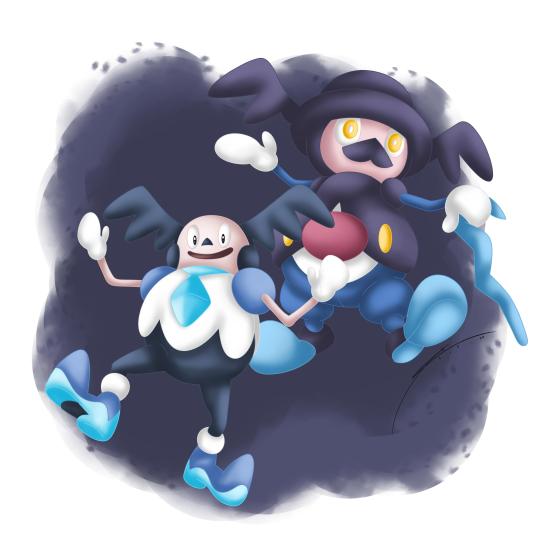
Art by DarkraiLady
STATS
Kalosian Mr. Mime has a whopping 120 Special Defense, but a mere 40 HP, seriously inhibiting its ability to actually tank, and only 65 physical defense. It’s 100 Special Attack is respectable, but Speed 90 isn’t really enough to make a sweeper out of it, even with Nasty Plot.
Galarian Mr. Mime balances its stats a bit, trading Special Attack and Special Defense for a bit more HP and Speed, but the only thing here that really works out in its favor is that it can equip an Eviolite, turning it into an actual defensive Pokemon, albeit one that still has poorer HP than most.
Mr. Rime brings up most of its stats as evolutions do, but weirdly drops its speed from 100 to 70. It manages to be more defensive than average post-evolution, but its key stat becomes its 110 Special Attack. Overall, its stats are fine, able to dish out hits and take them, and its worst stats are only a bit below average.
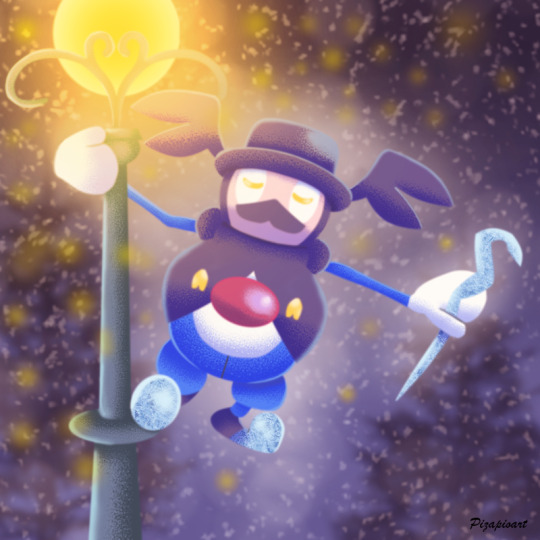
Singin’ in the Snow by Pizapioart
ABILITIES
Kalosian Mr. Mime and Galarian Mr. Mime have entirely different abilities, with Mr. Rime having another.
Like Electrode, Kalosian Mr. Mime can get Soundproof, and there’s plenty of Sound based attacks out there, making this a decent defensive option. This improves in 2v2 where you can pair it with Boomburst.
Filter, a near-Signature ability of Mr. Mime, is another powerful defensive option, reducing the damage of supereffective moves from 2x to 1.5x. As you can reasonably expect most opponents to have Poison, Steel, or Ghost moves somewhere in their lineup, you really can’t go wrong with this.
Technician increases the power of any of Mr. Mime’s moves of 60 power or less by 50%, and in theory this is a good ability, but Mr. Mime just learns all the good moves anyway. There’s no reason to use a Technician’d Confusion when you can learn Psychic, or a Technician’d Magical Leaf when you can learn Energy Ball. Skipping this should be easy, because it’s Mr. Mime’s Hidden Ability.
Galarian Mr. Mime (but not Mr. Rime) gets Vital Spirit, which grants immunity to sleep. This is fine and usable and plenty of enemies will try and put you to sleep, but this isn’t the reason you’d be using this Pokemon.
Mr. Rime gets Tangled Feet, which is a garbage ability for garbage Pokemon. Nobody needs raised evasion when confused, what they need is to not be confused.
Ice Body, hidden ability of Galarian Mr. Mime and Mr. Rime, causes a Pokemon to heal in Hail. Of course, every Pokemon that can get this, other than the not-fully-evolved Seel, takes no damage in Hail anyway, and it really takes a fully defensive playstyle to worry about using your ability on sometimes healing 1/16th max HP a turn. There are ways to build Mr. Rime for this, but it’ll involve other Poekmon on your team setting up the Hail and wanting it, too.
Besides, Galarian Mr. Mime and Mr. Rime have the signature ability “Screen Cleaner” which negates Reflect, Light Screen, and Aurora Veil upon switching in. This ability is honestly the best reason to use these Pokemon, more than anything they’ll actually do once on the field. Any ability that has an effect on switch in tends to be good, because as long as it’s something you wanted done, you basically just got a free action.

Art by PeregrineJazmin, formerly Retkikosmos
MOVES:
Psychic and Psyshock are both great options for your primary attack form. Psychic is a bit bigger, but as you’ll have a special move of your other element to fall back on, Psyshock adds a bit more versatility.
Kalosian Mr. Mime’s only Fairy attack is Dazzling Gleam so you take Dazzling Gleam. Galarian Mr. Mime/Mr. Rime gets your choice of Ice Beam, Blizzard, or Freeze-Dry. Freeze Dry has the drawback of being weaker most of the time, but extra strong against Water Types, which are rather common. Blizzard is more likely to outright end something, but without Hail its accuracy is rather poor.
Coverage options are pretty wide for the mimes. Thunderbolt, Energy Ball, Shadow Ball, and Focus Blast are available to both, with that last one being super effective against the Steel types that resist Psychic, Fairy, and Ice.
If you think you’ll get a moment to build up, Nasty Plot is always a great move, as is the more defensive Calm Mind.
Mr. Rime gets two particularly interesting options: it can Rapid Spin, which combines well with Screen Cleaner to reset the field, and it can learn Slack Off, the normal type equivalent of Recover.
The Mime family’s move pools are actually rather deep, and there’s plenty more options in there, like Hypnosis, Reflect and Light Screen, Baton Pass, Iron Defense, Stored Power, and, via older gens, Healing Wish.
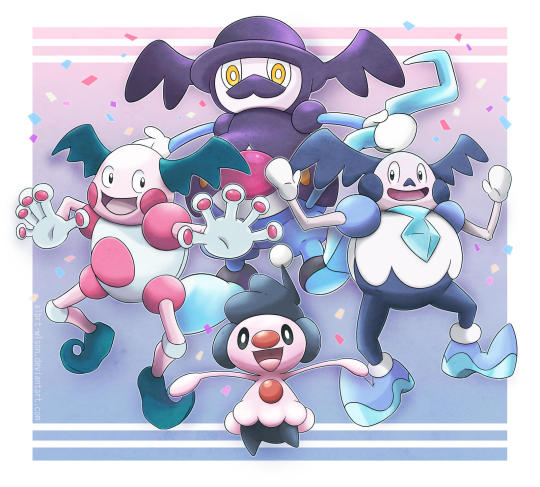
Art by albrt-wlson, which I have to assume is short for Albert Wilson, but might actually be Alberta Walesong.
OVERALL:
I love to hate Mr. Mime, though overall the whole family winds up in the range of ‘fine.’ Mr. Rime’s speed loss is its biggest hit, but other than that there’s a lot of good stuff it can do, especially with both Screen Cleaner and Rapid Spin. Having below average speed on a Pokemon with so many weaknesses is a problem, but with such a strong variety of moves there’s a lot that can make up for it.
Kalosian Mr. Mime, unfortunately, really needs that stat boost that Mr. Rime got or the ability to use Eviolite like Galarian Mr. Mime, and it just doesn’t have either.
The other thing that really bugs me about Kalosian Mr. Mime is its abilities or lack thereof. In flavor, Mr. Mime is THE Barrier Pokemon. Reflect and Light Screen are supposed to be what it does better than anyone else… but it just isn’t. Sure, Soundproof, Filter, and Technician are interesting, but I’d have loved to see Mr. Mime have something like Prankster or an ability that mimicked Light Clay, anything to say ‘this is the Pokemon that is best at Reflect.’ Honestly it’s a problem I see in the game a lot, a Pokemon having a specifically mentioned ability or a clear signature move that the Pokemon just has no reason to use. At least Mr. Rime clearly wants to use Teeter Dance with Tangled Feet, even if that strategy isn’t a strong one.
It just really bugs me when a Pokemon isn’t good at what it’s supposed to do, even if it’s good in other ways.
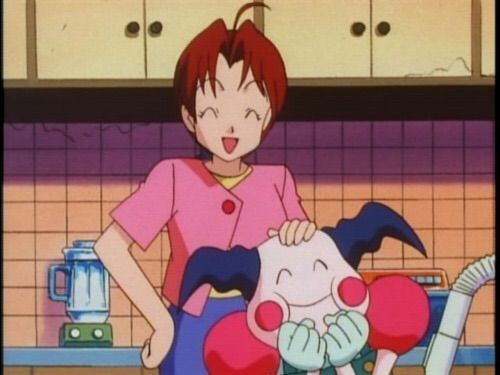
13 notes
·
View notes
Text
We really need 1:1 time passage in games.
I play a lot of games. I particularly play a whole lot of RPGs, strategy things, survival games, and these all tend to be games that try to create an extra sense of immersion with hunger, thirst, and a day night cycle. And WOW do they ever end up doing the exact opposite with the implementation!
Like, let’s just start with food. If I am playing a survival game, and I choose not to eat for a while, my little hunger meter will bottom out, and I will start taking damage then eventually die. This tends to take like, one real life hour/in-game day, give or take to kick in, and then death comes within like, maybe 5 minutes if they’re generous? And I stave this off by... usually finding, killing, cooking, and eating, 2 entire turkeys per real hour/in-game day.
So... what the hell is any of that!?
So we have hunger, and we’re representing it as this slowly draining meter you have to keep an eye on. Already, that’s just weird. In my experience, you can go an entire day, not eating a damn thing, and not feel a thing out of the ordinary. But when you do actually get hungry, it can be overwhelming and impossible to ignore (have you eaten yet today by the way? My meal schedule’s gotten totally weird). Nothing about that makes sense to simulate as a slowly lowering bar. If you want realism, you have absolutely no onscreen hunger meter, and then like every 4-24 hours or so you have some incredibly distracting hunger indicator kick in and stay kicked in. Like, activate rumble packs and leave’em going at a steady pulse sort of annoying. And it gets worse when you’re actually preparing food.
Also feeling hungry is not an early indicator that you are going to suddenly die of starvation, or even that you’re anywhere near that point. I had dinner 6 hours ago, I’m a little hungry now. It varies a lot, but actually starving to death can take upwards of going TWO WHOLE MONTHS without any food at all. Like if we’re representing that as a meter, “hungry” kicks in when it drops to 99% full. Starvation is not a particularly common cause of death. If you’re dying of starvation, either someone is intentionally starving you to death, or some horrific catastrophe has just wiped out completely absolutely every potential food source in an area you somehow cannot wander your way out of even if you have months to do so. Relevant real world fact- Any time you see stuff about people dying of starvation, that’s never “farming just is not a thing that works in this area,” it’s “some malicious tyrant is actively preventing these people from accessing food in a deliberate effort to cause them to starve.” It’s really not actually a concern in any sort of survival story, unless we’re going real long term.
Meanwhile, have game designers ever actually, like, eaten food? Like I said, 2 whole turkeys per real hour/game day seems to be the going standard and like... have you had a turkey? I live in America, there is this tradition on Thanksgiving to go get a turkey, spend a day cooking it, and serving it as part of a meal served to one’s whole extended family. You’ve got that one turkey (granted, generally with a lot of side dishes) feeding like... a dozen people, easily. And at the end of the day, you’ve only MAYBE collectively made your way through like half a breast. You carve up a bunch more and send everyone home with a ton of leftovers. Then you’ve still got this giant mountain of turkey left, and you’re eating it for like the next week until you’re completely sick of turkey and throw the rest out, with plenty of meat entirely uneaten on the bird. Or hey, do you eat hamburgers? You know how the standard for a really kinda too big to responsibly be ordering it hamburger is “a quarter-pounder?” Which refers to the 0.25 lbs. of meat on the bun? Just quickly googling “beef weight” and copying the preview text from the oddly named first hit, on beef2live.com... “An average beef animal weighs about 1200 pounds and has a hanging hot carcass weight (HCW) of about 750 pounds.“ I can’t honestly say I know what “hanging hot carcass weight” is and I kinda doing want to, but I’m assuming that’s how much you have to work with after stripping out all the bones and organs and such. Multiply that by 4 to get how many oversized burgers you get out of one “beef animal” (why does it not say cow? I’m growing increasingly unsettled)- 3000 burgers. Give or take. You go smack that one Mnecraft cow with your sword, you should be fine for like 5 years. At least assuming we’re not simulating food spoilage. And if we are, HEY THAT TAKES SIGNIFICANTLY LONGER THAN ONE DAY, 2 IF YOU SALT IT!
And I mean, on top of that, we’ve got this whole standard I keep citing of 1 real world hour/1 in-game day. That kinda seems to be one of the more common standards for the passage of time video games use. That or 1 minute=1 hour. And I... really don’t understand why we have these scales?
Like, the earliest example of a day/night cycle in a game is Dragon Quest 3, where 1 steps on the over world map=12 minutes passing, or 120 steps=1 day. That’s a weird scale I’m having to use, but that’s because as the most traditional of JRPGs, DQ3′s sense of both time AND space are super abstracted and walking a short distance across the world map is this super compressed and simplified conveyance of a big long epic journey through the untamed wilderness. The first games I can think of offhand to really do it as a real time elapsed ratio thing are like... The Sims and GTA 3? Let me look at each of those in turn in a bit here.
So, The Sims has to pass days pretty quick, because that’s like, the whole idea. We’re watching this little household drama unfold in a compressed time scale... but the scale is really messed up? Like, we start off pretty simple. Sims work their shifts of like 9-5 on the in-game clock, need an appropriate amount of sleep... but then MOST things have timing based off having animations play at a reasonable pace, which is to say, 1 to 1 time, not 1 to 60. It takes like 3 in-game minutes for a Sim to get up out of a chair, several more minutes to walk to the kitchen and even start cooking, altogether just getting up, making a meal, cleaning up, and sitting back down is going to end up being this hours long affair, most of that being travel time from one room to another. It’s weird, and practically speaking you end up having them eat one meal, use the toilet once, and take a shower once per in game day, because less than that problems occur, and more than that, it’s a huge pain. And forget conversations. Those are like 12 hour commitments.
And then we have GTA3, where 1 real minute=1 in game hour... and this isn’t tied to anything in-game at all really. You don’t eat, you don’t sleep, nothing really has business hours to deal with, the whole day/night cycle is just there to give you a nice cycling change of scenery... and also again, breaks immersion, because the animation speed is 1:1. According to a video I just watched, walking end to end across the map of GTA3 takes a full 48 in-game hours (121 in GTA5). And I mean... there’s races, and high speed chases, and all this other stuff that according to the in-game clock are at such slow speeds you can barely tell anything’s moving. It’s weird and arbitrary! And also unnecessary! Like, I’m pretty sure I sank at least 80 hours into my first playthrough of GTA3. I definitely spent enough time cruising around any given island that if time passed in a 1:1 ratio, I’d still see what everything looked like at every time of day. And hell if you rigged it up to a real world clock I could plan around that, do all the cool missions right at sundown.
But I mean, also, there’s these things called movies and TV shows? You may have heard of them, because it’s where games get a whole bunch of terms they use all the time. Like camera, and scene. So the thing there is, when, say, a movie switches to a new scene, they’ll often arbitrarily jump the day/night cycle ahead by several in-movie hours, or even days, so the lighting is appropriate to what’s going to happen in that scene. You can actually just... do that in games, too. It’s OK. Nobody’s going to stop you or say it’s breaking immersion. I talk to this guy to start this mission at what’s clearly noon, then we fade to back, and I come back out onto the street late at night so I can do this daring nighttime raid. That’s.. OK. You can do that. Honest. No need to have the sun doing crazy fast laps in the background.
Anyway, other games since have all copied that time scale, because blindly copying things from GTA3 was kinda... how people made games for a good stretch of time (and yeah yeah yeah, Elder Scrolls was probably already doing it, whatever... hell so was Robinson’s Requiem I’m pretty sure, and Drakken I know was paced something like that). But anyway, we mixed that sort of time scale with Survival Gameplay and we’re just kinda mashing these problems together. We’re doing everything in this one to one time scale, but the in-game clock is running at like 60 times that, and our already ridiculous food intake needs are downright absurd, and suddenly we’re destroying absolutely all life on sight to sate our ever-present ravenous hunger (and possibly never sleeping).
And like... survival games don’t actually need that? Like the interesting bits of the angle are finding sources of things like clean water and shelter so you don’t die of exposure once the sun’s down and stuff. And these are things you really just need to do once and you’re set. You could... basically set up a whole game, running in real time, where these are early potential fail states. Get some kind of shelter set up within the first 5 hours or so, sleep to advance straight to the next day after pulling that off, then you have like 3 days total to find drinkable water, and... honestly at that point we’re talking like a good 45 minutes of gameplay and you could really end it there, or start your last goal. But instead, no, we’re making some kinda crude axe/bow and killing everything to eat.
Not only is it not realistic, not only does it take me out of the experience by checking the math, the whole affair feels kinda like I’m being put through someone’s weird hyper-masculine cargo cult fantasy of what it would have been like if they grew up Hunting With Dad and like.... OK people who actually do that still kill like one animal, then drag it home, throw it in a big fridge, and eat it for quite a long time, or sell it, or leave it to rot because they’re just really into ending the lives of innocent creatures and don’t want weird gamey meat at all.
So yeah, just let time be time, and don’t ever actually make me eat if we’re trying for some kind of gritty realism thing. I really don’t get hungry nearly that often and fill up quick.
20 notes
·
View notes
Text
Late to post, but here’s Week 2 of Spellbound.
-
Aug. 22
I woke up around 11AM.
Did some video editing and started uploading the footage of me drawing that Remus pixel portrait of Remus.
The did some dishes and made today’s Hello Fresh Meal. Mushroom Penne with truffle cream. I liked it to a middling extent (I’m enjoying truffle more myself, but I recognize how intense of a flavor it is). But yeah. It was met with a “meh”.
Spent a few hours updating some logs and documenting last few day’s of events. Then, I did today’s exercise.
First, today’s DD. 40 climbers with EC. Pretty fun and breezy. I tried to land lightly on my feet this time - just to feel graceful like that.
Last, Chapter 7 of the SbP. I was to charge and cast “Healing Level 1 Spell“ to help an NPC out. I rested about 1′ in between sets - it was mostly breezy yoga... mostly. Glad the up/down dogs were done in pairs, the child’s pose was a nice breather too. Really felt the fatigue build-up when it came to that plank hold. But it was pretty satisfying to transition between exercises as smoothly as possible!
Did some online shopping and watched YouTube before bed... late again.
-
Aug. 23
I woke up after 11AM.
Did some chatting and whatnot before getting in today’s exercise early (which was welcomingly chill.)
First, today’s DD. 1′ plank punches with EC. I counted exactly 60 reps today, so I’m fairly happy about that pace!
Last, Chapter 8 of the SbP. I was to charge and cast “Tracking Spell“. It was nice to just do meditation again. This required 10′ and I focused on breathing from the belly as best I could. Mind wandered a lil but that’s just how it goes. It was still pretty relaxing!
Chill was disrupted by a transient health scare with Dad... threw my entire day off. Was supposed to be movie night, but between anxiety about that and fear that things would interrupt movie time. But chatting and browsing stuff helped a bit.
I got to bed obscenely late again.
-
Aug. 24
I woke up around 2PM.
Had technical issues but more notably there was a pretty loud/angry argument bro had with the Uncle about his negligent cooking and mess-cleaning leading to the kitchen sink being backed-up.
There was shoving involved. Fucked me up mentally for a good while, if I’m totally honest... I tried doing some Sides analysis and chatted for a distraction, before doing my exercise.
First, today’s DD. 40 scorpion twists with EC. A little less fun to do with a slightly full stomach. But oh well. I like the exercise well enough.
Last, Chapter 9 of the SbP. I was told to charge a couple more spells.
First had to be “Shield“. Variable rest times, today. I could feel the jitters start to melt as I went along, so that was more than welcome. Some ankle complaint noted from the jumping lunges, but at least it wasn’t very many of those.
Second was just any attack spell - I charged “Wind Blast“. Pretty variable rest here, too. Kinda didn’t want to do a lot of floorwork today - but I do think I hit the arms a bit harder for it. Still gotta be mindful of your elbows for plank rotations, too.
That helped dial down the jitters I was having for a bit... so did chatting and trying to sketch a fan art idea out.
But I still wound up pulling an allnighter because I was an anxious mess today... I didn’t really get much done other than some rambling on the fandom blog and watching YouTube...
-
Aug. 25
This morning I did some dishes, made a trip reservation, ranted on Twitter about sources of distress before taking a couple hour nap.
Spent most of day chatting and browsing stuff.
It was a bit late, but I did get in some exercise today.
First, today’s DD. 2′ single leg hops, without EC. Had to drop at 1′30″ mark, rested a few seconds to finish up. Only counted the the longer set’s reps - 120. Honestly, sleep-deprivation REALLY didn’t help.
Last, Chapter 10 of the SbP. Casted the “Shield” spell, though I’m not doing the probability check, the roll I got was a success anyways.
Then I was to charge & cast, “Healing Level 1 Spell“ again. Whoo boy... eating jalapeno poppers was NOT the smartest decision shortly before this. Gave myself some heartburn and coughing because of said heartburn. But I powered through that. :I
Then, I hit the showers and washed my mask. Browsed tumblr for a bit before hitting the sack. Happy but unsurprised by managing the yellow zone. Exhausted and I had somewhere to be tomorrow.
-
Aug. 26
I woke up around 11AM.
Went to Seeking Safety Group. Went alright.
Got home and spent some hours streaming/making that glitchy, hellish mash-up I did for silly reason. Also spent time chatting and browsing about.
Very late, but I managed to get in my exercise around 11PM, tonight.
First, today’s DD. 2′ side leg raise with EC (1′/1′). This was pretty breezy to get through. Get more out of this if you can make a right angle with side of hip to floor.
Last, Chapter 11 of the SbP. I was to charge and cast the “Super Strength Spell“. Variable to max amount of rest taken between sets, this time. Tried to make the push-ups decent. But it was pretty easy to get through this in a timely fashion.
Spent rest of my night doing Sides analysis stuff. Got to bed obscenely late... only saving grace was that it was before noon. :/
-
Aug. 27
I woke up around noon.
I spent most of my day chatting and doing that Sides analysis stuff (interpreting pairing platonically positively.) I wound up writing like 2.3k words on that instead of fic writing... woops.
Did my exercise late.
Spent vast majority of my day working on a positive analysis of all the Sides pairings [platonic intent], set to post tomorrow. Had a lot of fun chatting about it too. I wrote like 2.3k words on it... orz
First, today’s DD. 2′ O-Pose with EC. That definitely got me trembling the whole way through. Things got real after 1′ and legs started to feel like dropping in the last 20″. But I’m really happy I managed it. This is a personal favorite exercise. Very meditative!
Last, Chapter 12 of the SbP. I was to charge and cast the “Invisibility Spell.“ Max rest. The plank rotations were the hardest part - everything else was pretty manageable.
I did get to bed too late, almost in the yellow zone.
-
Aug. 28
I woke up a bit after 9AM.
I had to go to my psychiatrist appointment today. Went alright... got a chance to share that scary!Remus art with him. I did mention the acute shit that’s been happening... but also my more positive coping stuff.
Got home and when the Hello Fresh arrived - I did dishes and made today’s meal. Italian noodle soup. This was another chicken sausage based soup - pretty enjoyable. Bro liked the kale soup more. But at least I think it was more accessible for pops and his lack of teeth.
I was already tired at that point... but I had to help deal with kitchen sink problems I didn’t realize were an issue. Whatever the Uncle did to “fix“ the sink broke it and it was leaking the entire time I was doing dishes! Fucking hell.
Had to take another shower after that.
Active rest day, only devoted exercise was going to be today’s DD. 40 raised leg circles with EC. Not a fan of neck strain. But doable. Just glad it was only that with my energy levels.
Got to bed later than yesterday.
1 note
·
View note
Text
My Money Snapshot
[Inspired by Corporette]
Location: Ohio, small college town
Age: 29
Occupation: PhD candidate (English)/half-time instructor
Income: $16,000 before deductions
Net worth: $588 (I’m crying)
Current Debt: $12,844
Living situation: Renting with a roommate
Money Philosophy:
I grew up in the “working poor” category. My parents are divorced and my father never contributed much financially. Mom made around $21,000 per year at work and she cleaned houses “under the table” to supplement that. Somehow, we never went hungry, what we ate was relatively fresh and healthy, and she managed to put two of us through Catholic schools for a total of 14 years. I know now that mom is still paying some of those loans and credit card debts and that part of her strategy included not contributing more than the 3% that her employer matched in her 401k. Every time I complain about the financial stress I feel at my salary level, I have to remind myself how comparatively unstressful my financial life is.
I’ve always been poor and I always knew that graduate school/academia is not a lucrative career. I tell myself that if I can make things work at this pay grade, then I’m ready for just about anything. My main strategy is to have a budget, stay in the budget, and save every bit that I can.
Monthly budget
$1000-1100 for the necessities each month. Monthly spending on eating out, entertainment, shopping and other categories varies widely. I also won’t lie... dating someone who makes 4x more money than me helps... I’m fairly frugal on all of these fronts: I buy most of my clothes second hand and I tend to shop seasonally. Spikes in spending occur around the winter holidays when I’m buying gifts and when I am doing traveling. And I also have totally weak, impulsive moments - like the $3 soap sales at Bath & Body works, or that time I spent $110 on bras and underwear on a whim. Anyway:
Rent: $272.50/month
Other living expenses: $130-170/month (electric, internet, phone, renter’s insurance - lower in summer, higher in winter)
Transportation: $332/month (gas, insurance, car payment)
Healthcare: $162/month (health+dental insurance, no vision coverage)
Groceries: $120-150/month ($30/week)
Debt Picture
Student loan: $2000
Car loan: $10,488
I’m a career student & my motto for all the years I’ve been in school has been “follow the money.” I went to college on very hefty scholarships and I only had to take out the $2000 loan to cover housing costs during my first year. For the subsequent three years, I was an RA, so I never had to take loans again. I applied to graduate programs based on the research fit, and when I got my offers, money weighed heavily in the decision. I would have loved to live in Boston as a wee 22-year old, but I wasn’t about to take out loans for a year’s worth of tuition and the living expenses. And to get a PhD while living in Minneapolis, my very favorite city in the US? It would have been such a dream, but for the quite steep difference in stipends and the significant disparity in cost of living compared with Ohio. My only regret on this front is that I haven’t started paying back my tiny student loan. I’ve been able to defer it since I’m in graduate school, which was a great idea when I was a master’s student who didn’t know the first thing about budgeting. But if I had just paid $25/month from the start of grad school the balance would be $0 about the same time I graduate from this PhD program this August. Instead, I’ll be scrambling to pay off the whole balance before my 6 month grace period ends.
The car loan is less than a year old. I finally broke down and bought a new (by which I mean used) car last summer after really pushing it with the car my parents had bought me in high school. Repairing that car put me into credit card debt more than once and I was getting so stressed about it. It was time. I have a very good credit score, so I qualified for a nice loan rate with my credit union, and to get a better rate I got my mom to co-sign my loan. It’s a popular rental fleet model so there were tons of them on the market, but average miles were high - so when I saw one that was two years old with only a years worth of miles on it at $1000 less than the average price for that make, model, and year, I jumped on it. My payments are $231/month on the 5-year plan. Currently, I’m paying that minimum, but I plan to escalate my payments as my income goes up (I’m on the academic job market now, pray for me). I folded this car payment into my existing budget by giving up solo-living and finding a roommate. When I had my own apartment, very spacious with a huge kitchen and tons of windows/natural light, I was paying about $585 for monthly rent. I hate living with people, but I hated the idea of being trapped in this college town without a car even more - one of my other mantras is “you can do anything for a year.”
A note on credit cards: I love them. I’m one of those responsible people that charges everything and pays the balance like clockwork every month. This is the only way to make sure you’re actually taking advantage of the cash back/reward perks! Currently, I’m using Capital One’s Venture card and stockpiling airline miles for travel (it has a 40,000 mile sign-on bonus). If you’re good for it, I also recommend one card with a great balance transfer program. For me, when I get into an emergency situation, it makes me feel like I have options. It’s been about 4 years since I’ve had to use my balance transfer card to cover costs ($1400 in car repairs, summer 2015), but at my level, I can’t afford to not have back up plans.
Savings and Investments
$5,517 Cash
$7,861 Roth IRA + employer mandated retirement account
Retirement: The biggest financial mistake I've made in grad school is that I did not opt into the retirement account offered by the university when I started my M.A. in 2012. When they ask me that “what I wish I had known before I went to grad school” question, this is near the top of the list. I did, eventually, open a Roth IRA and slowly I started to build something. This year, when my graduate funding dried up and they made me a “half-time instructor” the retirement account for public school teachers was mandatory and the contributions are high: 14% of every pay check (annoying, yes, but on the flipside, there is an equally high employer match). While I’m contributing to this, I’ve paused my contributions to the IRA. I’ll roll this money over, either into the IRA or into another state/employer retirement fund when I move on from here.
Personal savings: I strive for a minimum of $100 per month and frequently do a little more, but each month is different and I consider it a win if I break even. Through most of grad school, I’ve taken on “second jobs” to bolster what I can save (and boost my resume). Both jobs have been through the university, so they limit me to five hours a week. When I max them out, this can be an extra $200-250 each month.
I took up a new savings challenge this academic year to build on my “play money” savings account (a high yield savings account which my bank labels a “goal setter” account). The challenge involves tallying the “total savings” printed on my receipts each month (i.e. when the grocery store is like “you saved $6″ because of sales and coupons). So, At the end of the month, I put that running total into my goal setter account. Sometimes the total savings are like $26, but others its as much as $171. It’s an interesting challenge because it encourages me to do tedious things, like scroll through all the digital coupons on the grocery store app; but at the same time, I know that the higher that number is usually coincides with a lot of shopping which encourages some self-regulation.
I initially set my goal at $2500 when I opened the goal setter account in 2014. When I had to dip into the account in April 2018 to pay $930 in car repairs, I finally set plans in motion to buy my car. Since I bought used, I only put 10% down on the car (just over $1200). When I sold my old car for $1000, I put that money right back into the account to start saving for new things...
What I’m saving for now:
travel: to celebrate finally finishing this PhD, I’m hoping to pull off a trip to Europe. Later this year, I’m also turning 30 around the same time that one of my regular professional conferences is meeting in Hawaii. If I can do one or both in the next year, that’d be grand. (As I mentioned, I'm saving up airline miles with my credit card program, too!)
a multicooker: think InstantPot...but more expensive because my dreams all revolve around small appliances that match my stand mixer.
What I do to be frugal...
I’ve been frugal my whole life, but a couple of major habits I’ve formed include:
Meal planning and home cooking (read my guide to meal prep here). The money part of that means planning what I eat around maximizing the ingredients I have to buy. I plan meals that use the same ingredients so I’m not spending on an entire bunch of celery and then throwing out 75% of it. Routinization also helps, so my grocery lists stay about the same week to week and the bill relatively predictable - for example, I eat avocado egg salad almost every day for lunch. I know, avocados are not cheap, but I also believe in spending on the things that nourish you––literally and “spiritually.” Roxane Gay once said that she never bought avocados or blueberries when she was a “poor grad student.” Once she started making money, she realized she would buy them because she could afford them, but she also threw them out all the time because she didn’t plan her meals right to actually eat them. The point is, buy the foods that you like/feel good about and build habits around them. It’s not wasted money. That said, I won’t pay more than $1.25 for an avocado!
Second hand clothes shopping, especially for my business casual (it’s amazing what people donate to the Goodwill, barely worn!)
31 notes
·
View notes
Text
Five Things You Should Consider to Plan the Best Tanzania Safari

When planning a safari trip to Tanzania, people think Serengeti and the Great Migration, but there are a couple more things to consider. It will help you get the most out of the experience while enjoying the most famous African natural wonder.

How Much Time?
Up to four days
People often ask me how much time I should spend in Tanzania, and that is a complicated question to answer because it depends on the individual. It depends on your budget and what you like to see.
I would recommend nothing less than a three-night safari focusing your time in one location. A three-night safari will often happen as a side trip, mixed with business while one is in the region and doesn't have much spare time.
Four to Seven days
Looking at four to seven nights will give you a bit more variety and you could even visit three different regions or parks to get a much better safari experience. Depending on your wishlist, one could also include Ngorongoro Crater with a Serengeti Safari without feeling like you are on a "Ferrari-safari" and be able to fit cultural experiences as well as a hot-air balloon safari.
More than seven days
Spending more than seven days opens up a whole list of possibilities and will be recommended if your budget and time allows. It is not always possible to allocate so much free time in one's busy "rat-race" lifestyle, but this is the way to go if you would like to replenish your soul.
Spending more than seven days will allow you to experience the elephants at Tarangire National park, the Flamingos at Lake Manyara (both depending on the time of the year), a picnic lunch inside the Ngorongoro Crater, local village lunch at Mto Wa Mbo, traditional Masai village visits, finishing on a high note in the Serengeti seeing the Great Migration in action. One can even add a side trip at one of Zanzibar's various lodges and hotels to end your perfect African safari.

What Would You Like to see
Cultural experiences
Tanzania is an extremely culture-rich country with over 120 different tribes, of which the Masai people are the most famous in the outside world. My recommendation is to get to know a couple of words in Swahili, which is one of the two official languages in Tanzania and is commonly used in the country. However, English will be great, and you wouldn't have any real problems communicating with the people. There is always someone that can translate if need be.
Should you wish to mix some cultural experiences and get to know the people, then there are quite a few places where you can visit a traditional Masai village and get to know their history. Mto Wa Mbo is another excellent example of getting to see how the Tanzanian tribes live, and the locals will welcome you into their home where you can experience a traditional lunch. For those looking for a bit more, there is the local village tour in and amongst the banana plantation.
These stops don't take that long and incorporate well in your travel itinerary, making it a pitstop en-route to your next destination.
Serengeti
The word Serengeti is synonymous with Tanzania and means "endless plains", quite the fitting name as it describes the Serengeti perfectly! The Serengeti is a massive National park, it spans for about 12 000 square miles, roughly the size of Belgium, and hosts the world's most famous natural wonder for the most of the year. It isn't straightforward to explain the emotions that one gets when seeing thousands and thousands of wildebeests and zebras, as far as the eye can see. The Southern Serengeti is best during the calving season, and the Northern Serengeti is best during the Mara river crossing when the wildebeest and zebra heads into the Masao Mara. The Central Serengeti is great year-round, and you are bound to see some big cats and other big-5 animals, no matter where the migration herds are located. I would recommend adding the Central Serengeti in your itinerary!
Tarangire National Park & Lake Manyara National Park
One of the lesser-known gems of Tanzania but worth your time! It should be considered if you like Elephants, Baobab trees, and Flamingoes. There are other species of animals in these regions, but the above will be the stars of the show. I've been to a couple of areas in Africa, including the Okavango Delta, and few places outside Botswana can compare elephant numbers like Tarangire National park. Lake Manyara is just right next to Tarangire National park and ties in well with the Ngorongoro crater into a safari circuit. You won't spend more than a couple of hours between Arusha, which is the central starting hub of the Tanzanian safari experience and the "main star" aka the Serengeti.
Ngorongoro Crater
Ngorongoro Crater is the world's largest inactive volcanic caldera and hosts its ecosystem with a wetland, forest, swamp, and open plains. The whole experience can be done as a day trip en-route and sits in-between Lake Manyara and the Serengeti.

Private or Scheduled Group Safari
Budget difference
People often tell me that they either don't have a clue how much they can afford, and this is all new to them. Booking a safari trip to Tanzania for the first time can be confusing, and one doesn't always know what the total package includes. There are quite a few things that add up to the total cost, such as the vehicle, fuel, the guides accommodation, the guide's meals, and drinks, accommodation, meals, possible beverages, park fees, etc. In my experience, the animals don't know who spent what, and the animals will act and react the same regardless of where your accommodation is based.
Pros of private
In saying that you will get the same animals "on-show", there are private safaris where the total cost, as mentioned above, is shared by the number of people in the vehicle. So if you are only one couple, then the total cost will be split amongst two people. This is often the more expensive option but gives you the flexibility of choice, the choice of camps, the choice of routing and National parks that you would like to see, and the choice of how much time you would like to spend per sighting.
Pros of scheduled - more basic and larger lodge style
Scheduled safaris are great and allow a broader range of people to visit this beautiful country and to experience the "stars of the show" with your own eyes. One can't alter a group scheduled safaris itinerary, but often what happens is that the ground handler will negotiate a much better rate with the lodges because of continued business, which brings the total cost down, more money in your pocket. A typical safari vehicle can accommodate a maximum of about seven people. Hence, the groups aren't that big and a great idea for larger families that could occupy the entire vehicle at a group safari rate. Group safaris are also great for single travellers that have been trending for the last couple of years. You get to meet new like-minded people and possibly meet your future best friend on the safari.

Main events on the Migration calendar
I feel it is vital to mention a few facts about the Migration before continuing. The Great Migration happens the whole year-round, and the animals follow the rain that provides them with nutrition-rich grass to feed on. Predicting the weather is not an easy task, and notably, long term predictions are nearly impossible. Discover Africa has been collecting data over the last few years from our herd tracker website. We are running this initiative with local rangers and guests. Herd Tracker has given us valuable insights into the movements and helps us to try and give you the best possible chance to stay as close to the Migration as possible.
Calving Season - January to March
There are two significant events on the Migration calendar, in which the calving season is one. The Migration usually comes to a short halt in the Southern Serengeti close to Lake Ndutu, where the calving happens. With the calving comes the predators, which can cause some action.
River Crossing - June to August
The famous Mara river crossing happens around this time of the year, and people often think of the Migration as one big massive herd, which is not entirely true. The Great Migration is made up of 100's of smaller herds travelling in the same direction, and in some areas, you will find higher densities of herds. This is the reason why you will find that the "front runners" will cross the river a long time before the back end of the Migration cross the river. It is challenging to guarantee a river crossing sighting because people don't know when the animals are going to take the leap and decide when is the best time to cross. The animals could bunch up next to the river for days before crossing.

Getting around
Light Aircraft
The two transport options on offer will be closed 4x4 vehicles and light aircraft transfers accompanied by the lodges open-air safari vehicles for the duration of your stay. I would recommend a mix of both to give you the best of both worlds. I've been privileged to experience both on a Tanzania safari, and it was fantastic to end the trip with a Light Aircraft flight, seeing the aerial view of what we experienced on the road towards the Northern Serengeti.
A light Aircraft is an excellent option if you don't want to spend 2 - 4 hours on the road or if you only have limited time to spend on safari.
Road transport
My personal favourite will be the closed 4x4 vehicle with the pop-up roof. You get to see the smaller villages en-route, we even saw street performers along a dirt road between lake Manyara and Karatu, close to Ngorongoro Crater. The longest time we spend in the vehicle was about 4 hours from Ngorongoro Crater to the Southern Serengeti. Still, we stopped at a real traditional Masai village on the way, allowing us to stretch our legs and get to know the Masai culture firsthand by one of the Village Leader's sons. We also spend so much time with our guide that ends up being friends at the end of the safari, and your guide gets to know you, what you like, what animals you want to see, and what animals you haven't seen yet. All these small things add up to a great experience!
There are other things to consider when planning your safari, such as booking in advance, the Migration is a worldwide favourite, and there are only so many camps and beds for people to stay at. I would be more than happy to share my knowledge and passion for this beautiful country, Called Tanzania, with you, and help you navigate through all the information. Tanzania should be on everyone's bucket list!
Till next time...
Matthys
Tanzania Safari
0 notes
Text
Sandman
I’ve tried a lot of sandbox games over the past year. Mostly driven by acquiring a PC and leaving my Mac to its scheduled obsolescence. Playing games on a Mac is like playing Doom on a calculator. You celebrate that it works, it actually works, but it usually fails to be more than a proof of concept. When I switched back to a PC I discovered an entirely new realm of stubborn design. At least it wasn’t getting slower with each update and it deigned to play all manner of toys. Being quite turgid for roleplaying games I set about catching up with every RPG the Mac had denied me and checked out some more for good measure.
A common feature I discovered in many of these games is what I call the Back Breaker. You lift the game up high, then crash it down over your knee, broken. You are now free to explore the game how you choose - all of its secrets are laid bare. A lot of people get very upset at the inclusion of Back Breakers in what they hope will be a game with an ever ascending skill requirement. The notion that the audience is primarily there to explore is an insult - where, they ask, is the game? Personally I like this feature, I like that the end game is to become a god. This is why a lot of you will disagree with my assessments.
Skyrim
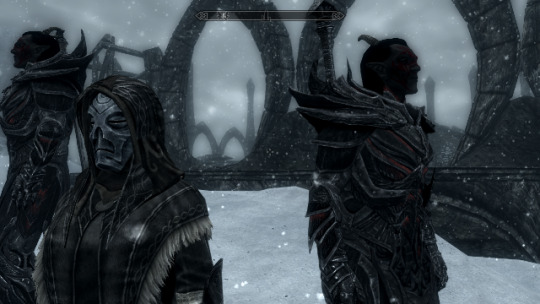
The sticking point for many people with this one is the combat. It’s dour grey-brown landscape invites a comparison to Dark Souls (I’ll get to that one in a bit) so people like Matt Lees will remark that Skyrim is an inferior counterpart. If you’re looking for tight combat in Skyrim, then like a 1st edition iPhone 5, you’re holding it wrong.
It insists you take it seriously over an unskippable introduction to the most tired hook that any roleplaying game can throw - the prison break. After shaking your screen as hard as it can with an assault by a dragon you are thrown into a scant and confusing interface in a land of ugly robotic people who are super fussy about what time they’re willing to sell things. On my 1st playthrough it got dark, so dark I couldn’t loot the mages I was killing for their expensive robes. I quit and rerolled a khajiit, purely because the wiki told me they had nightvision. It wasn’t until much later I discovered that there were many means of creating light, some of them causing fantastic AI behaviour (I nicknamed the spell Magelight; aggro-ball). Some short way into the terrible main quest line I thought, “sod this”, and went in search of the mage college to learn how to blow things up like some of the monsters were doing. This haphazard adventure was some of the best gameplay I’d ever encountered. A scared lowly girl-cat, picking her way through a hostile landscape in hope of learning real magic. Typical that when I finally arrived at the college I encountered the first blatant design wall in the shape of an unclimbable pillar that the college sat on. I barely had the mana to cast the spell that would prove me worthy to train there. A few hours later I was the archmage of the college. It would take many more hours before I mastered glitch-riding: taking the cereal box collision space of my horse and rubbing it against the prettiest parts of the scenery until it yielded to let me ride vertical. Out of the many hours of play the only real low point was getting turned into a vampire, I had to look up a wiki on how to cure it and reload many times because the quest to stop vampirism is broken.
There are many Back Breakers in Skyrim - I chose twin dremora lords that I chain-summoned to lock up the AI. But truly it is Skyrim’s pretty mountains and their unresolvable collision meshes that are the best. Only after hours of play does one develop an art for sniffing out details that defy edge-case-programming. Skyrim is a perfect mess. I know why they keep re-releasing it, they got lucky. One need only play the Dragonborn DLC to see Skyrim at its worst. It is a hard game to recommend, for it is not really a game, it is a thing both ugly and beautiful.
% out of 10
The Witcher 3

“Stick with it”, they say. Few games deserve such an epithet as this one. The controls are fiddly. One’s inventory is so dense with options that I didn’t realise that my potions refilled themselves until I’d nearly finished the game. After which my character sported full-body-priapism as I quaffed every decoction available. The turning point from hating this game to loving it was a side quest where a character caught Geralt off guard when being subject to the witcher’s advice - the townsfolk declared him a freak not because he was like Geralt, but because they were intolerant of homosexuals. I then got drawn further into the man’s drama. Every single story this game presents is trying to be Not So Simple. It’s a manifesto that leaks into the game’s bestiary that tells you not only what a monster likes for dinner, but your best tactics for killing it. But then, it’s Not So Simple as killing a monster, there is always another layer to each story.
It took at least three score hours of gameplay before I started skipping some of the many cutscenes. One of them was the infamous sex-on-a-stuffed-unicorn. It was a fault of the main storyline being so lackluster. I never really cared for Ciri, I found her even more fiddly to control than her tutor. But the extra layers that surround it: the Bloody Baron, stupidly shagging Keira Metz, the numerous detective scenes - they all carry this game. It is a shame it takes a few hours for it to reveal itself.
I must commend the map design for being sensible enough to be broken into several parts. You first explore a tutorial village before moving into war torn Velen and its haunting soundtrack. Here you work until you can gain passage to the north, the islands, and your home. Many sandboxes simply give you one map to conquer and contort it to stop you wandering into the final challenge. It’s refreshing to move on to a clean map, full of new challenges and surprises.
I couldn’t be arsed to play Gwent.
Trophy out of Archgriffin
Zelda: Breath of the Wild

This game has three stages: Delight, Depression, and Exploration.
Delight
Oh wow, there’s so many things to do. And so many things interact with one another. The sense of discovery comes not only from reaching new locations, but also finding new ways for elements to interact. Of course wood burns. Of course burning creates an updraft. Of course metal conducts electricity. Even after many hours of play there are still new things to find. So strange that the game is as dense as it is... empty.
Depression
Ugh, I don’t have a horse and I’m in yet another blank area. Ugh, I lack just enough stamina to climb this mountain, I’ll have to start all over again. Ugh, I can’t stay in this area because I take damage and the food I eat to stop it only lasts ten minutes. Ugh, I complained about all of this online and everyone keeps saying, “I don’t have a problem, the game works fine for me, Git Gud.” As often as I meet people who have played this game in excess of 100 hours, I also meet people who have played it for less than 10. If you are unlucky, if you don’t make the right connections, if you don’t stumble upon the right thing, this game is truly depressing. Made more so by the amount of people who cannot fathom why anyone would have trouble with the game. And yet there are many that do. It is not really that they need to be better at games, it is merely because they have not found the Back Breakers. Or worse, they do not appreciate them.
Exploration
After needless hours of collecting (grinding) you find yourself in possession of armour. You upgrade the armour again and again and suddenly the cloud of depression is lifted (if it was ever there). You are free to explore any edge of the island, you simply need to wear the right threads. At this stage of the game you have found many secrets but still keep finding more. Korok seeds, the OCD baiting puzzles, become a delight to find. It’s hard to remember the game ever being frustrating, but it remains in the back of my mind. Zelda BotW has a hump, a hump that some people will feel very aggrieved to surmount. Do not be surprised when you hear of someone bouncing off this game - it really is torture for people with precious little play time or patience.
Perhaps I should say something about the shrine dungeons or the 4 beast dungeons. They exist. There, I said it.
96 out of 120
Path of Exile
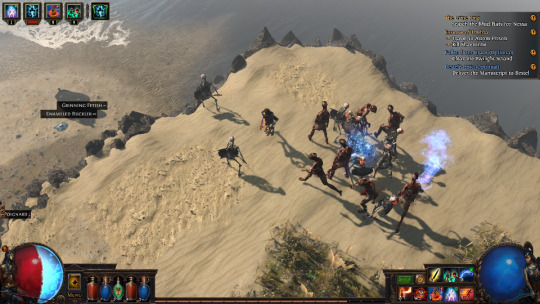
I tried this many years ago on my Mac using some sort of Windows executable wrapper. It did not work. I tried again when I got my new PC, I was underwhelmed. I tried yet again two weeks ago - holy shit this is the best action RPG I’ve ever played. The fact that it’s also free is sort of a weird blessing. You can only buy cosmetics and extra slots, so it even has a total lack of pay-to-win going for it. At least they get to keep expanding and updating it, which is probably why my recent play through was so smooth.
Diablo 2 is one of my all time favourites. It’s a concise loop of murder, loot, sell. But not without flaws. It has cruft, tedium, and imbalance in spades.
Path of Exile shuffles the formula and bets the whole thing on loot. Skills are loot. Money is loot (you pay with scrolls and item modifying tools, no gold). Equipment is loot. Yet playing it like Diablo is quite a silly thing to do - you get almost nothing from items you try to sell to vendors, so you no longer make trips back and forth with junk items. Leveling up is spent on a massive passive skill tree shared by all the classes, so the game sees no need to forestall leveling because it’s not the gatekeeper of mechanics. The items are. This occurs by way of gems that you socket into items, a bit like Diablo 2 and 3, but instead of boring damage bonuses you get entirely new mechanics. If you play with several characters in the same league they can share these items as well (providing they are strong enough to wield them). A mere ten levels into the game I had a full on rave of undead surrounding my witch character like she was the hottest new DJ at a halloween party.
I refrained from playing on hardcore because the game is online only and my internet sucks, but the game does boast a challenge that is mandatory hardcore. A multi-part dungeon that rewards you with a new section for your skill tree. Complete it without dying and you get to specialise. This is further complicated by deadly treasure rooms you must salvage keys from in order to unlock the many chests at the end. This was quite an exciting challenge with real stakes and real swearing when I let my greed get the better of me.
So what of its flaws? It takes a few goes to shake off the Diablo conditioning, so it’s not until you hit act 2 and try again from scratch that you figure out a strategy for building a character. The passive skill tree has a handy search feature and after I typed “minion” into it I was determined to carve a path through the best parts. If you don’t plan your route, you miss out on your mana rocketing back to full, your health restoring, or in my case: zombie disco. It’s online only and if you insist on playing over the weekend it can be a very choppy experience. The chat is a sewage pipe, a stream of edgelord douchebaggery. Go into the options and turn it off. I’ve yet to meet anyone that wants to form a party and every time I look at it I’m certain I don’t want to. There’s little to say of the story, it’s not bad though. I appreciate that it doesn’t try to get in the way like Diablo 3′s did. Perhaps if they had taken their loot thesis a step further they could have buried it in the game’s items. Then all this hoarding would have expanded into something like an archaeology dig. A missed opportunity.
O-O-O-O-O-O-O-O-O out of Shiny Armour
Shadow of Mordor

It’s quite cool and exciting to begin with. We’re in Mordor with lots of grim orcs and cool cutscenes, and... is that a bush? Oh okay, it just popped into existence. Nevermind. Well at least sneaking around is fun... my finger hurts a lot though because they want me to hold down the trigger button for ages. Yeah, ganking orcs is cool, it’s real fun shooting them in the head... oh, I have to do these crappy sword fights where I only press two buttons throughout the whole thing.
This game is like someone who seems fascinating and pretty from afar, but soon as you talk to them at length you begin to realise that they’re quite boring. They just say the same thing over and over. It’s a sausage party that gets slowly more off putting as I play. The developers don’t even seem to know that women exist outside of being trophies or reasons to be angry about stuff. The main draw in this game is apparently the battles with the orc leaders, which I found to be the most boring part of the game. I hated the sword combat and it kept dragging me back to it. After doing every arrow and dagger challenge I could find on the map I left the game and never played it again.
Gollum out of Mordor
Dark Souls

in my game Ending I structured the second level so that the player would step forward and get a slap to the face in the shape of an unfair death. This was my opening salvo, death is your education. So after persisting with Dark Souls I’m somewhat nonplussed. I get it. By repeatedly killing the player they form a mental map of the area. By repeatedly killing the player they encourage experimentation.
Except that this doesn’t always work. There has to be some investment on the behalf of the player or this magic completely fails. If the player feels like they can walk away, they will. And they do. It’s why I believe Dark Souls is such a hit with game reviewers, they are beholden to persist, and in doing so the game makes a believer of them.
I on the other hand couldn’t care less. A tedious march through the same janky fights to get to the same boss I still don’t understand is nothing more than that. I tried a variety of combat techniques, from trying to interrupt attacks, to blocking, to evading, all of it very unsatisfying. What little progress I made illuminated the premise, to internalise the map and hone my skills, but I was not impressed. I enjoyed not one second of it, I only endured. I experimented and I explored, but never was I delighted.
The very worst thing that Dark Souls has given us is complacency towards killing the player. I have heard designers remark that it didn’t matter that the player died in that spot in their game because Dark Souls kills the player all the time. It makes me want to shake them. Dark Souls does not kill you all the time, it kills you for a specific reason. See, I get it, I get Dark Souls, I just don’t enjoy the combat.
Soul out of Estus
Divinity Original Sin 2

I had the worst time with Divinity Original Sin. My two characters insisted on bickering and ruining every conversation - no matter how many times I reloaded a scene they would find a way to trash it. I eventually found myself locked out of every quest in the game and unable to fight my way past monsters higher than my level. I was playing the game to forget about a failed relationship where my ex would find excuses to start arguments. It was about as bad an experience playing a game I could ever hope for.
To say the sequel is an improvement is true. To a point. Somehow I’ve done it again and gotten trapped in an area with no quests to advance and monsters too powerful to fight past. I’ve muddled my way past some really irritating quests with obtuse requirements that I’m told can be solved in many ways. Except that when you fail to chase a particular lead it’s really frustrating to have to try a dozen different tactics to shake out a solution. It feels like I’ve picked up my PC and I’m rattling it over my head until the game agrees to let me move on. People keep telling me I can solve situations in dozens of ways, but all of them seem very specific and very intent on being a dick about it.
The combat is as amazing as it is chaotic. Environmental effects are at the fore, making it feel very D&D-like as you slow people down with oil and then ignite the oil and so on. The story I felt was okay, but the tone is all over the place, making it impossible to give a shit. Some nice touches with elves gaining visions from eating flesh and anyone can choose perks for talking to animals - but I found it more infuriating than cute after searching an entire island to solve a riddle, only to have a rat explain to me that I had to talk to some NPC again in order to shake, shake, shake out the solution. For every ounce of fun I got two ounces of frustration and misery.
1 out of 2
Dungeon World

Out of all the table top roleplaying games I’ve tried, this one was the most robust for casual play. Especially seeing as roleplayers are the most unreliable people on the planet. The resolution system it employs forces a plot twist every time you use it, so it’s impossible to plan anything. It’s not for everyone, you end up with a very gonzo story without the fiddly depth that other roleplaying games manage. On the other hand it’s a dream to be the Games Master and watch a story unfold instead of meticulously planning it and seeing a conclusion land that tears apart your ideas instead of adding to them. I wrote a full guide of how I run this game over here. The campaign is effectively a sandbox, I let people explore and fill in the map as we go - which is why I mention it. I’d like a computer game that approached it this way, not like Dwarf Fortress where a randomly generated overworld is dumped on you. Instead I’d like a piecemeal discovery of the world, one that reacts to the tensions you’ve created. Perhaps I’ll have to do it myself.
Story out of Players
2 notes
·
View notes
Link
October 09, 2019 at 08:00AM
Carter Roberts’ motorized wheelchair didn’t arrive until the day he died.
It had been a long time coming and his parents had fought hard to get it. The chair cost more than $32,000 and the insurance companies wouldn’t cover it, so the family went to court. One insurer eventually agreed to pay for some components of the chair but not the whole thing. And then none of it mattered anyway. On Sept. 22, 2018, the Roberts’ doorbell rang and the chair was delivered. Also on Sept. 22, 2018, Carter died, just three months shy of his sixth birthday. He had been largely paralyzed for the final two years of his life. The family is only now beginning to pick their way through the horror of what happened.
“Our eight-year-old daughter believes she can speak to him,” says Carter’s mother Robin. “She was playing video games the other day and she’s looking up and going, ‘Carter are you seeing this? I need your help.’”
By any measure, the Roberts family of Richmond, Va. was spectacularly unlucky. They lost their son to a disease that science first recognized only in 2012. It’s new enough that it didn’t even have a formally accepted name until 2014. When it got one, it was one of those names that is more or less just a clinical description of what the disease is: acute flaccid myelitis (AFM), a sudden inflammation of spinal tissue resulting in flaccid paralysis of the muscles of the limbs, neck, face and often diaphragm. It’s a lot like polio but it’s not polio; it’s a little like meningitis and Guillain-Barré syndrome but it’s not them either.
Ilana Panich-Linsman for TIMEBraden’s nurse and mother set him up for treatment.
Indeed, no one knows exactly what it is. For the moment it remains rare: In the U.S., where AFM is closely tracked, the disease attacks fewer than one in a million people even in peak years, and it very rarely kills. But in the past seven years, it’s been striking more and killing more, and there is a tick-tock certainty to when it will hit next. As with polio, AFM is seasonal—though unlike polio, it arrives in late summer and early to mid fall, rather than in the spring and summer. Also unlike polio, it runs in an every-other-year cycle, peaking in even-numbered years.
While spotty outbreaks of AFM have been retrospectively diagnosed in the U.S. from 2005 to 2012, it was in 2014 that the disease established its current pattern. That year, there were 120 confirmed cases scattered around the country; in 2015, the total fell to 22 cases; it climbed again in 2016 to 149 cases; fell again in 2017 to 35 cases and jumped back up last year to 201 cases. So far in 2019, there have been 20 cases of AFM in nine states.
Now, as an even-numbered year inevitably approaches, there is a growing feeling of looming menace. When 2020 arrives—and then 2022 and 2024 and on into the future—more and more children are destined to be claimed, unless science gets a handle on the disease fast.
“This is our generation’s polio,” Carter’s mother, Robin Roberts says flatly.
That’s not just the opinion of a grieving mother; doctors admit to feeling daunted too. “I can’t think of a single disease that had this pattern that we’re seeing, with modern laboratory diagnostics not figuring it out,” says Dr. Nancy Messonnier, director of the CDC’s National Center for Immunization and Respiratory Diseases.
As with polio too, the medical community has mobilized. Back in the 1930s through 1950s, the work was led by the National Foundation for Infantile Paralysis, the non-governmental consortium of scientists that included Jonas Salk and Albert Sabin, who developed the two different versions of the polio vaccine. This time it’s the U.S. Centers for Disease Control and Prevention (CDC), which last fall formed a task force consisting principally of 17 epidemiologists, neurologists, pediatricians and other experts from teaching hospitals and health departments across 10 states, as well as from the National Institutes of Health and the Bill and Melinda Gates Foundation.
Ilana Panich-Linsman for TIMERachel Scott helps her son Braden walk down the stairs in their home.
The task force had its first meeting in December 2018 at the CDC’s headquarters in Atlanta, and the gathering had the feeling of a war council. Every seat at a massive conference table in a windowless room was full, with doctors and other staffers lining the walls and epidemiological maps and graphics on display screens.
“This is obviously complicated or we wouldn’t be in this place,” said Messonnier in her opening remarks.
Lending urgency to the task force’s work is that AFM seems not only to be getting stronger, but crueler too. As recently as 2014, the median age of AFM victims was seven years old; then it fell to five and now it’s just four and a half—kindergarteners. Like polio, it strikes at just the point when children are fairly defined by their happy, kinetic energy—and then it takes it away from them.
“It was kind of surreal to be like, ‘Wait, how rare is this? One in a million? You’ve got to be kidding me,’” says Jeremy Wilcox of Herndon, Va., whose four-year-old son Joey contracted AFM in September 2018 and lost the ability to walk, but has largely—though not entirely—recovered.
Roberts and Wilcox were in Atlanta in December to address the task force. Their ostensible purpose that day was to describe the nature of the disease to the doctors, who at this point understand it far less well than the lay families living its terrors. But the more pressing and powerful reason was to humanize the problem—to establish the mortal urgency of solving it.
“AFM has changed my life,” says Rachel Scott, mother of a third child, Braden, who is battling the disease, and who also attended the meeting. “It’s changed my children’s lives; they’re growing up in a completely different world than they would have. This is not something I ever would have dreamed of.”
Braden Scott, whose family lives in Woodlands, Texas, first came down with what seemed like a routine summer cold on July 4, 2016. But the next day, when he tried to eat so much as a single potato chip, he couldn’t keep it down—not because his stomach was upset, but because the muscles that control swallowing had begun to fail. “He got weaker over the next few days and we came to realize his swallowing was paralyzed,” says Rachel.
Ilana Panich-Linsman for TIMEMuscle-stimulating pads are placed on Braden’s back for treatment.
Eventually, the paralysis spread throughout Braden’s entire body below the neck, including his diaphragm, which meant he had to be intubated in order to breathe. He spent seven months in the hospital as the most acute phase of the disease receded and he received in-patient rehab, but even now that he’s home, his walking remains unsteady, paralysis continues in his left arm and his swallowing is still so poor he must be fed a liquid nutrient four times a day through a port in his stomach. Merely controlling his swallowing enough to clear saliva is a challenge, and though he’s back in school, a nurse who accompanies him must periodically suction his mouth so that he doesn’t choke.
“Every day when he comes home from school, we say, ‘OK, how many mouth suctions today?’” says Rachel. “Sometimes it’s only three and we’re like, ‘That’s amazing!’ The things I celebrate are absurd.”
Like so many AFM patients, Braden was at first misdiagnosed. When his parents rushed him to the hospital with fever and spreading paralysis, the doctors said his problem was mononucleosis and strep; they prescribed him antibiotics and steroids and sent him home. Joey Wilcox was first suspected of having Bell’s Palsy—his face was partly paralyzed, so what else could it be? The doctors eventually sent him home with no medicine and a vague diagnosis of a virus, one they said was likely to pass on its own. Carter Roberts’ family was told that he was merely tired and needed rest.
In many cases, the correct diagnosis doesn’t come until full paralysis has set in and doctors finally conduct an MRI of the spinal cord looking for a lesion or some other localized explanation. By that point, the extent of the disease can be startling. “Carter’s cord was so inflamed they couldn’t even distinguish between gray matter and white matter,” says Roberts.
If the damage AFM does shows up clearly on a scan, the cause of the disease doesn’t leave clear fingerprints, though experts have good reason to believe it’s a viral illness. Its seasonality is consistent with viral behavior—the way colds and flus strike in the fall and winter and polio in the spring. The biannual peaks are not unusual for a virus either. “Measles before vaccination was every two years as well,” says Dr. Thomas Clark, the CDC’s AFM Incident Manager.
Ilana Panich-Linsman for TIMESome reminders of Braden’s treatment hang on the wall in the Scott family home.
But measles—and polio, chicken pox, rubella, and other childhood viral diseases—are very different infectious beasts because they are all caused by a discrete virus, which can be detected in the blood and neutralized by vaccination. AFM is murkier. It’s thought to be associated with at least two different enteroviruses—viruses that incubate in the gut. There are hundreds of enteroviruses (including polio and influenza), and so far the ones designated EV-D68 and EV-A71 have been most widely implicated in AFM paralysis. But “widely” is not even close to “universally.”
During peak years, no more than 30% of AFM patients show some traces of EV-D68; another third show EV-A71 or other stray viruses; another third show nothing at all.
Even if the two enteroviruses turn out to be to blame, no one knows exactly how they do their damage. While the poliovirus directly attacks the ventral horn cells in the spinal column, it’s entirely unclear what EV-D68 and EV-A71 do to the central nervous system. The best analogy might be to Guillain-Barré, an inflammation of the peripheral nervous system that usually results from a misfiring of the immune system after an infection with a stomach or respiratory virus.
The mention of Guillain-Barré predictably gets the anti-vaccine crowd chattering, since a slight increase in the risk of the disease has been observed among people who receive the flu vaccine—on the order of one or two additional cases for every million vaccinations. (The CDC stresses that the risks associated with severe influenza—including death—are far worse than the far smaller risk of Guillain-Barré.) There is no evidence at all of any link between AFM and any vaccine, but the CDC all the same is investigating any possible connection, simply because good epidemiological sleuthing requires no possibility be overlooked.
“We’ve always thoroughly looked at vaccine safety in all of our programs,” says Patel. “Currently, we don’t have any evidence to suggest that there is an association.” Clark adds that the children who have developed AFM have generally been vaccinated in the same way and on the same schedule as the tens of millions of children who don’t get sick.
Ilana Panich-Linsman for TIMEOne of Braden’s nurses, Carly Westcott, RN, helps prepare him for therapy.
The more epidemiological avenues that reach a dead end, the more researchers are concluding that they are coming up against a disease more complex than they reckoned. “AFM can’t have a simple answer because if it was, all these smart people would have figured it out,” says the CDC’s Messonnier.
What alarms the CDC is the possibility that the medical community could face wave of cases before that figuring out can happen, and polio offers a precedent. The earliest documented polio outbreaks were mild: four cases in the U.K. in 1835; ten in Louisiana in 1835. In 1894, a major outbreak struck Vermont, when 132 children fell sick—and after that, the disease exploded. There was an epidemic of 27,000 cases in the U.S. in 1916, including 9,300 in New York City alone. In the years after, there were thousands—sometimes tens of thousands—of cases every summer in the U.S., with the peak coming in 1952, when 57,879 polio infections were recorded. The epidemiological fever didn’t break until 1955 when the first polio vaccine was approved.
If there are similarities in the AFM and polio infectious profile, there are big differences in the prognoses. Polio paralysis always seemed intractable—sudden and effectively permanent—while AFM patients can regain much of their function. That may say less about the infectious agent and more about the therapeutic options that are available in the 21st century and weren’t in the 19th and 20th.
Patients have access to a far better array of prostheses and far more thorough physical therapy programs than they would have 100 or even 50 years ago, with kids today sometimes working up to five and six hours a day to regain mobility. Braden Scott receives regular muscle therapy, which he refers to as “zapping,” and it’s a fair enough term for what the seven year old goes through several times a week. In each session, medical technicians paste 48 electrodes to his arms and legs, which send synchronized signals to various muscle groups mimicking the electrical commands the brain would normally send the muscles to get them moving. Regardless of the source of the signal, the impact on the muscles is the same: the motion serves as exercise, preventing the atrophy that can occur when a limb is unused. The nervous system benefits too, with the signal channel between the spine and the limb remaining open.
Ilana Panich-Linsman for TIMEBraden uses his toes to reach for a LEGO on a break inbetween physical therapy treatments.
Braden also underwent a relatively new surgical protocol known as nerve transfer, in which a healthy donor nerve from elsewhere in his body was left connected to the spinal cord but was rethreaded to his left arm, where AFM destroyed an existing nerve. Three years out from his symptoms, he continues to improve—but slowly. The tracheostomy tube that helped him breathe will soon come out, but his improvement in eating and swallowing normally—which takes the complex interplay of multiple muscles in the head and neck, as well as coordination with the throat to protect the trachea—has been much slower.
Inevitably in the U.S., any disease—especially a newly identified one with treatment protocols that are by definition unproven—will run into the wall of the health insurance system, with parents dividing their time and energy between tending their sick child and fighting simply to get coverage.
“It’s hell,” says Roberts, who battled for the wheelchair that came too late for her son. “You’re just dropped blindly in the middle of a labyrinth that is health care. You’re grasping at walls and corners trying to feel your way out, and no one is willing to hold your hand or give you a GPS.”
Toward the end of Carter’s life, his doctors recommended a drug to ease his breathing, but the insurance company refused to pay for that, too. “I pushed back as far as I possibly could until a final denial after eight months,” says Roberts. She wonders to this day whether the drug would have made a difference.
Ilana Panich-Linsman for TIMECaroline Casanova, LVN, one of Braden’s nurses, checks his blood sugar as he watches TV with his brother.
Joey Wilcox has mostly recovered, a year out from his initial symptoms. He still has some paralysis on the left side of his face and a bit of a limp in his right leg, but when he first got sick, he was so weak he referred to himself as a “floppy human.”
“I’m thinking it may have come from a video game,” says his father, Jeremy. “He said, ‘Am I always going to be a floppy human?’ My wife said no. I didn’t answer and I don’t know if I would have given the right answer because saying to your child, ‘I don’t know’ is not comforting or reassuring.” If medical history is a guide, comfort does come, reassurance does come—cures and vaccines do come. But they come only with time and only with work—as the calendar moves inexorably to the next even-numbered year.
0 notes
Text
Maddie’s Big Gigantic Breath of the Wild Write-Up Where I Talk About Things I Like and Things I Didn’t Like
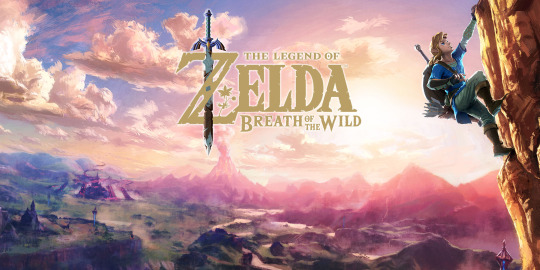
And regrettably, there are many things I did not like. But that doesn’t make this any less of a fantastic game that I enjoyed - I just wanted to put all my thoughts down in one spot. And yes, there’s spoilers.
--------------------------------------| Things I Like | ----------------------------------------
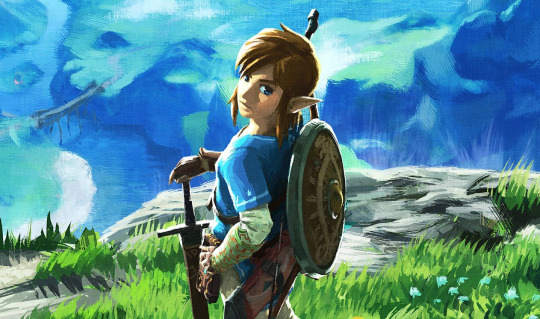
You can read any review for the game and that’s pretty much this section. There’s not much to say about the core game that hasn’t already been said, dozens and dozens of times, by professional or at least more knowledgeable game reviewers and critics out there.
Breath of the Wild (BOTW) is a big return to the uttermost classic Zelda feeling, of being a plucky hero in a big world that’s yours to traverse and discover, and get through on your wits and skills alone. But I’d actually argue that BOTW does the sense of open world and exploration far better than any other Zelda game comparison, not for the size of the maps (and man oh man they are big) but in that it gives you all the tools you need to explore within the first area and then kicks you out the door into the world. Any and all Zelda games, including the first, regardless of how “open” and non-linear you think they are, have a formula in that to progress through certain points, you must find an item that allows you to do so. BOTW dismisses that notion entirely and teaches you the core game mechanics and gives you the tools to explore wherever you want after the first area, and that’s a good thing. I spent the first several hours (upwards of a collective 20 or so) getting lost and just exploring, cooking food, finding side quests, fighting monsters, scaling mountains, and in a big way that’s sort of how the game is intended to be played. It’s full of creatures to hunt or befriend, hills to snowboard down on your shield, an expansive and hilarious physics engine to exploit, NPCs to meet and quests to be found and completed.

I like the provinces on the map, they’re either classic Zelda locations or call-backs to places from past games that weren’t always in Hyrule (large Majora’s Mask vibes, which makes sense, as this game takes place within the Child Era timeline). Even places that seemed the same at first ended up having subtle or severe differences, and of course the crisply-rendered graphics make the world vibrant, bright and inviting. While I miss the big orchestral scores I’m used to from other big console Zelda games, the subtle atmospheric music ended up being very nice and tonally appropriate, with familiar tunes sneaking in here and there in fun and sometimes beautiful ways.

NPC designs are unique, expressive, and full of character. Towns and hubs have a real sense of being lived in, with their own culture and way of life. Locations have their own passive dangers and benefits that make the world feel exciting and treacherous, and you can take any kind of approach to all kinds of situations. You can make special buff food or elixirs (one of the most fun things to do because I love watching the little food bits jump around in the pot) to brave the elements or give yourself extra bulk, or you can wear specialty armor or clothing, or do both. You can dye most outfits too, and tame and register your own horses and customize them. While a part of me misses the iconic green garb, being able to traverse Hyrule on a jet-black steed decked out in skulls and tattered leather while my Link was adorned with sleek black armor and cloak is kind of the best (and you can get the garb later, and then just build a custom green outfit yourself, which is how I went into end-game) Any weapon is fair game to wield as well, which was another part I greatly enjoyed and gave an added sense to exploration and that “get by on what you can find” survival aesthetic the game provides.

There really is a kind of subtle, almost accidental thoughtfulness to this game’s incarnation of Link. The background plot of the game describes, shows, and in some areas at least implies that Link was not a plucky hero from humble beginnings that the series is used to - Link was a prodigy in BOTW, a son of a proud and excellent knight who was to follow in his father’s footsteps to defend the kingdom and the royal family. Since he was a child he was groomed for this roll, despite the stress it caused him, until he became a trained and powerful warrior, even going so far as becoming the knight appointed to Princess Zelda, and wielding the Master Sword. He was the Hero from the beginning and was raised and trained his whole life to fulfill that role.
And he failed.
For all intents and purposes, Link in BOTW more or less dies (well, it’s implied he’s just unconscious and on the brink of death, but for my joking need to continue this “Link is the Chosen Undead” Dark Souls joke, yeah, he died). All the pomp and circumstance and careful, strict training surrounding his life ended up meaning nothing in the final grand scheme against Calamity Ganon. And this narrative carries not just to Link, but to the other cast of characters and Hyrule as a whole - years and years of careful planning and preparation was not what was needed to defeat Ganon.
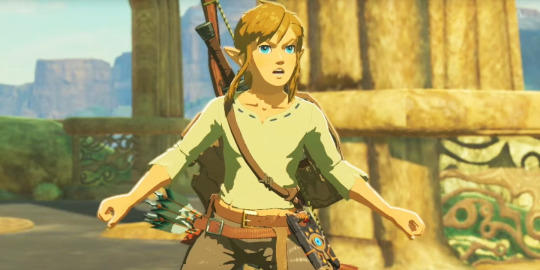
The game starts with Link being resurrected, with no memory of what happened 100 years ago and nothing to his name but a shirt and some shoes (and the Sheikah Slate I guess). But it’s this Link, stripped of everything, who has to cross the wilds and adventure, working his way up from scratch, completing test after test and trial after trial laid out by the ruined Hyrule and the ancient Sheikah sages in their shrines, who reclaims the Master Sword, earns the green garb (or doesn’t - you only get it if you complete all 120 shrines, which I think fits tonally because I wouldn’t exactly dub a guy who failed the first time a hero until he’s been thoroughly re-tempered for the task) and defeats Ganon. It’s not a bunch of strict, stately training given to a person who’s told their destiny from a young age and forced immediately to live up to it that makes a hero in Zelda games - it’s the plucky adventurer coming from little, courageously taking on feats bigger than them for the good of Hyrule and the people within it, working up to the final encounter.
Hyrule and the NPCs you meet echo that tone as well. It’s a world that’s had to pick up the pieces since Ganon re-emerged and laid waste to their world. Descendants and spiritual successors of champions from the past risking themselves for the good of their people, unprepared and outmatched compared to what they’re up against, but coming out on top with determination and follow-through in the end. The main story of BOTW has a bittersweet, but ultimately powerful and true-to-form Zelda tale that, on top of the immersion and pure fun the game provides is why it’s so easy to see why people have rated it so highly.
Unfortunately, extended playtime with this game revealed a ton of flaws and personal nitpicks, because despite what these scores claim, no game is perfect, and neither is BOTW.
----------------------------------| Things I Didn’t Like | -----------------------------------
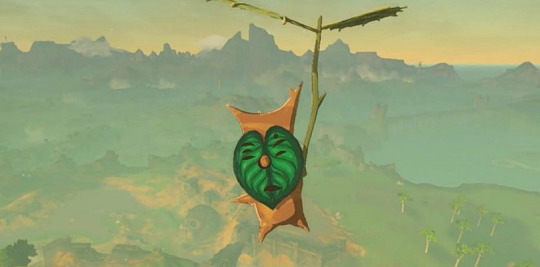
BOTW gets...repetitive, and at times annoying and even vacuous. I’d find a lot of really cool places during my exploration of Hyrule, but found that a lot of them just ended up being set-pieces to the world, with maybe a Korok hiding there (or maybe not, which was just super frustrating, climbing to a high mountain peak to find nothing up there). The game became measurably more enjoyable when I upgraded to full three stamina wheels, which took a lot of my early shrine upgrades to do, and that ugly, ugly little green wheel just constantly reminded me of how much I loathed it in Skyward Sword. I’d climb and climb and climb, usually not finding much of anything at the top later into the game. I’d find a set of interesting ruins, clear out the same enemies I’d fought 200 other times during the game, and not really find anything of interest within them. And god the enemies are repetitious. the same three core enemies in different colours, the same four or so core world bosses in different colours, the same Lynel and Guardians in different colours with ridiculous health bars that hit for 12 hearts a strike to impose the illusion of difficulty, when you end up just hitting them with ancient arrows, or using upgraded Stasis on them, or some other cheap trick because the combat and the difficult-to-time parrying and dodge/flurry attack prompts are not fun to activate (and if you fight them “properly”, especially the Lynels, get ready to run through all your resources).
When I go to a new area I want to see new enemies. Where are things like...I don’t know, Gibdos? Redeads? Poes? Darknuts? Skulltulas, Deku Babas, Gohmas, Armos, Dodongos, Aeralfos, Peahats, Likelikes SOMETHING ELSE besides these damn Lizalfos that keep JUMPING AROUND. I had one amazing encounter with a serpent dragon on an icy mountain peak, and had thought that I would have similar awesome encounters with the other two dragons in the game. Turns out the other two just sort of float around in locations and you don’t do anything with them except try to shoot them to farm items, no special encounters. Why.

I’d find a weapon I’d love but it would break quickly, so I ended up forming this habit of hoarding good weapons, bows, and shields, thinking I’d have to save them for later for fear they’d break, then ran into a problem where I was constantly getting showered in weaponry and had to play min-max on their attack numbers to decide what I was taking with me and what I wasn’t. I’d run into Koroks constantly to upgrade my storage space, but over time the malaise of searching for them after about 270 (out of a grand total of 900 Koroks) became too tedious and I stopped doing hyper-thorough canvasing of areas, especially because the canvasing didn’t really yield anything that exciting. I began, less and less, taking my horse places with me, because I could fast-travel and paraglide to locations I wanted to explore, and very often they were places I couldn’t even take my horse to. Armor variety, which I liked, ended up making a big chunk of food and elixir buffs superfluous and I no longer really felt a sense of danger or need to prepare for big exciting ventures into the bitter cold or so on. And upgrading armor ends up being a nightmare, as high-end stuff requires farming very precious materials, and if there’s one thing I did not like about Skyward Sword, it’s farming for materials.

Environmental hazards that could not be overridden with food or armor, particularly rain, halted my gameplay. I’d be trying to scale a cliff and, whoops - it was raining, which means you slip all the way down or exhaust your stamina trying to force through it. I’d have to go somewhere else and halt my progress on that spot, or attempt to find a place to make a fire and wait out the rain, which seems realistic in theory, but disrupts gameplay in practice. There’s also this weird abundance of cold areas in the game, but only really one hot area and only one “you’ll literally catch on fire here” area. A lot of shrine tests revolve around the same combat trial against the same enemy with a fluctuating health pool and do not get me started on the frustrating motion control mechanics for a few. I played the game on the Wii U as I did not want to get a Switch just yet, and suffered draw distance, framerate and even freezing issues. I figured this was an issue with the Wii U hardware, but hilariously it turns out this is an issue on the Switch as well (as an aside...it’s not really a good idea to have your flagship launch title with your new console be a game that the console can’t even run...)
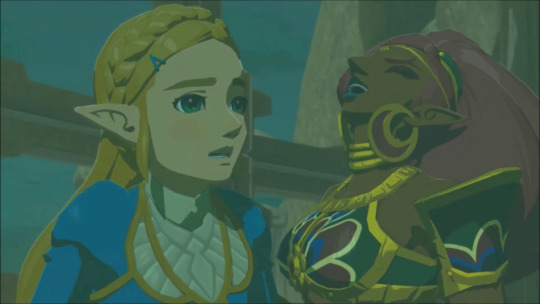
Then there was the story. I know I just talked a lot of good about it, but the thing is, the tones and storytelling I was talking about come across as...accidental, a sort of side-effect of the game as a whole. I don’t really play Zelda games for top-tier story - let’s be real, Zelda games do not necessarily provide enriching, unique narrative experiences. They are fun, generic adventure games with action-RPG elements, and that alone is enough to make them classics beloved by so many. But it’s been 25 years and the world of Zelda has expanded into a deep-reaching and ridiculous lore, enough that it has enough content to provide for a hard-cover art book, a historia featuring a collective timeline with three branching routes, and an upcoming encyclopedia. As years go by, narrative elements in Zelda games, such as story and character development, become larger and more prominent as the series develops. This is not a bad thing, and as a huge Zelda lore nerd myself it gives games a bit of extra appeal for me personally.
The issue with BOTW, and maybe the Zelda series as a whole, is that it’s kind of “blooming late” on the story and character narrative department in a generation where huge arcing epics with deep and relatable characters run regular in a lot of mainstream triple-A titles. BOTW, for example, is the first Zelda game to feature voice acting, something I was very wary about when I first heard about it, and ended up being rightfully wary. No it’s not terrible - the cast is doing the best they can with the stilted dialogue and passive direction they clearly had to work with, but it creates a very underwhelming and at times embarrassing experience that shouldn’t be so in a time when English dubbing/voice acting and localization is at some of it’s best (though not always of course), especially for a big-name title like Zelda from a big-name company like Nintendo. If this was the first time they were going to try voice-acting, this doesn’t really inspire me to look forward to it being a repeated trend in other titles. And even then, there’s actually only a handful of scenes that are actually voice-acted, with the rest of it being the usual textbox scrawls with some vocal sounds over top like in previous games, which begs the question as to why they bothered to go with the voice work at all.
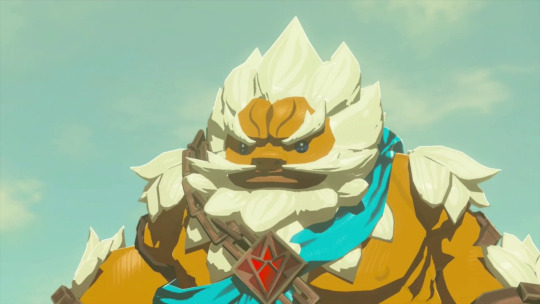
BOTW does something I refer to as A Plot and a B Plot, the A Plot being the main over-arching story of the game and the B Plot beside an over-arching side-story of the game. Typically, A Plots are the here-and-now of a form of media, it takes place in the present, with the B Plot being in the past, the future, or behind the scenes but being woven into the A Plot. When I set out to play BOTW, I thought that the failings of the past and it’s events would be the B Plot, with the A Plot as the here and now, focusing on new characters who would pick up the mantle of those who had fallen and see me into battle with Ganon. I thought I would follow the trials and tribulations of Princess Zelda in the A Plot, as well as the four champions, but it turns out, I was wrong.
When the game starts, the four champions are dead, and Princess Zelda is keeping Ganon trapped within Hyrule Castle, her power about to expend. At first I thought this was tonally appropriate - after all, they did fail, and it is supposed to paint a bleak picture of Hyrule. But this also meant that the only way for me to really learn or care about these characters was through optional flashbacks, and flashbacks are not really good tools to tell a story most of the time. I went and collected every memory, but didn’t really end up learning anything particularly new or exciting about any character other than Zelda herself - a wonderful character and incarnation of the classic princess, who is, honestly, a nerd. She’s an insecure scholar, burying herself in research to escape the stress of her failed ability to use her magic (Triforce, Light Force, I don’t know - the Triforce doesn’t feature at all in the game), the loss of her mother, and her honestly mean and scornful father and the doubtful whispers of her kingdom. She’s in over her head, and while her abilities and passion are best suited for studying the ancient technology and the Divine Beasts, at every turn it seems that she is forced away from this and told to focus on her destiny, that of using her sealing power to trap Ganon away. It plays again on that theme that pre-conceived notions and strict preparation in the name of prophecy and destiny and what have you still lead to failure, and that it’s through the heart of adventure and discovery that heroes that can defeat the darkness are forged. I expected that new champions would rise to replace the failed ones of the past, born from the adventure and sudden struggle of Ganon suddenly re-emerging, without any preparation beforehand. I expected Zelda to get her big moment where she proves that she doesn’t need old rituals and prayers to unlock her power, and that her inner strength comes from her true passions, and uses her research and scholar prowess to find ways to balk Ganon and use her power. I expected new heroes to rise and take control of the Divine Beasts in the steed of the failed champions of the past.
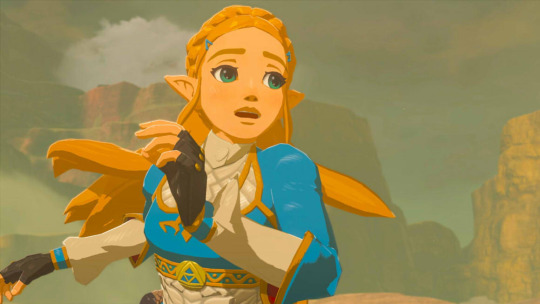
Well that doesn’t happen. The Divine Beasts get piloted by the ghosts of the fallen champions, who are ultimately dull and kind of not really likeable save maybe one or two. The new characters who help you get onto the Divine Beasts, which act as the “main” dungeons in the game, fall to the wayside and are forgotten after, apparently unable to become champions themselves (as only “champions” can board the beasts, apparently) despite the trials they face to assist Link and fight back against Ganon to save their people. The main dungeons lose their luster quickly too - they’re puzzle-based, requiring the same mechanic for each one (find five terminals, beat the boss at the end, each boss looks kind of the same). Something I thought was interesting was that each beast can be controlled from within, and you use that mechanic to solve puzzles. Two of the beasts end up using the same tilt mechanic though, and three beasts require shooting arrows at it to board (two of which are bomb arrows), and with the beasts’ interiors all looking the same it just sort of gets...a bit dull after a while. Been there, done that, done this, again. I really do miss more classic Zelda dungeons if just for the cheese factor, but this game does not have them.
Since the game has to use flashbacks instead of a continuous story to show the development and relationships of the characters (where dialogue is delivered unnaturally), the original four champions seem very one-note, defined by maybe one or two traits. The case of Revali is especially frustrating. Why is he so mean to Link? Is it his pride, did something occur between them, is it something else? We don’t know, we never learn, because primary characters introduced are not developed, he’s Just The Rival character, to fulfill the trope. His introduction in a mandatory flashback comes from Link literally looking at a bunch of planks of wood on a flight landing (I’m serious), and Revali is more or less an arrogant jerk to the end because That’s His Character I suppose. While we’re on the subject, the entirety of Rito Village is a wash - NPCs talk about how there’s nothing to do there, the Divine Beast is not causing any serious harm, it’s just not letting the Rito fly as high as they like and is being a general nuisance, the Rito that helps you board is just Some Guy and you don’t really see him again unless you want to do yet another optional and inconsequential mini-game. The dungeon is easy, borrows a boarding scenario from another beast, and borrows its in-dungeon mechanic from another beast. The whole area is such a let-down.
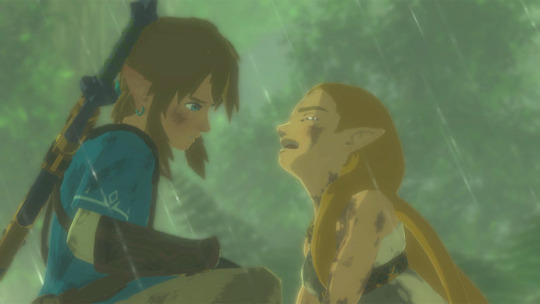
And then there’s Zelda, my poor, poor Zelda. She fails, just as everyone does, and I thought, and hoped, and prayed, just as I said before, that her inner strength would come through in the form of doing things HER way, using her research and her smarts, sticking it to the father and the people who didn’t believe in her by succeeding with the very methods they disapproved of. Well no - she activates her sealing power at the last second to protect Link because she loves him. It’s “tru wuv” that sparks her big character moment, where she does exactly what destiny pre-determined she do, not some awesome defiant moment where she pools her strength and self-confidence through her research and herself. She doesn’t even get to research and discover for herself that the power is apparently so closely linked to her “heart” or whatever generic nonsense works the magic this time - gotta love The Boy, that’s what makes you strong. And this is not extrapolating - when you complete all the shrine quests Kass the Rito bard gives, you can see him at Rito Village, where he tells the story of his teacher and the events just before the Calamity, and how his teacher fell in love with the princess, but the princess was in love with her appointed knight. The song his teacher taught to Kass after his teacher witnessed Zelda unlocking her powers was how her love for her knight was what brought it to the surface. Even the Zora champion Mipha, who I guess was supposed to be some callback to Rito from Ocarina of Time in a way, hints that her amazing healing ability is born by “thinking about who she cares about most”, and that’s not her family or friends or anything, that’s Link - who she loves and adores and wants to marry because that’s the Rito callback I guess.
I was so angry, it’s trite and tropey and ruins half the tone the game manages to do so well. Show me a BOTW Zelda who overcomes after failure not through “true love” and all the pre-destined nonsense that lead them all to failure to begin with, but the scholar she is using her research, her passion for knowledge, her wisdom, to unlock her power, to stop the Guardians, to seal Ganon.
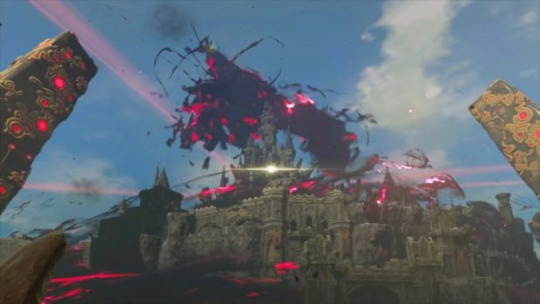
Oh and then there’s Ganon. “Calamity Ganon”, now a non-character - just an amorphous, shadowy entity of no real interest. I suppose you could say that after the events of Twilight Princess or Four Swords, Ganon(dorf) is really no more, no longer a proper physical entity, no longer the Gerudo man who had ambitions or menace or a tangible presence when he entered a room - that person was long since defeated properly, and it’s only the lingering malice, that sort of twisted essence of the primordial Demise from Skyward Sword, that remains. From a lore perspective that works, but it doesn’t make for an interesting villain, just like flashbacks don’t make for interesting storytelling and character development. The final battle in and of itself is hugely underwhelming too. Calamity Ganon’s first form is an apparently “incomplete” gooey, robotic spider...thing...it’s very ugly as a design in a game that’s had largely strong character and enemy designs, except for the Divine Beast bosses which, I guess fits tonally. And unlike other enemies where you can kind of take multiple approaches to the battle, you MUST bounce the laser beams in the second half of the fight back at the boss with either a shield parry or the Master Sword, which I think is the game trying to do the old “tennis mechanic” callback but it’s really...kind of janky and often unresponsive? The second form LOOKED much cooler and more tonally appropriate, with a huge, flaming Dark Beast out in Hyrule Field that I’d ride around on my trusty steed fighting. But instead Dark Beast Ganon just faces one direction only, shooting lasers at nothing. Your horse sort of meanders around and you just ride updrafts or stand safely beside it waiting for Zelda to shout very loudly and clearly about the GIANT GLOWING TRIFORCE-SHAPED WEAK POINTS you can hit with your Light Arrows - it’s all an exact, even easier version of all the “boarding the Divine Beast” scenarios you did earlier in the game.
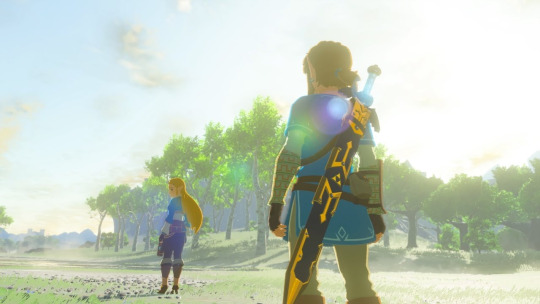
Zelda re-appears, seals Ganon, gives these really wishy-washy smiles and lines. The ghosts of the king and the Champions linger in the silhouette of Hyrule Castle and say nothing. We get no closure on the king and Zelda, who as far as the game wishes to imply in flashbacks and a hidden diary the king left in the castle, parted on extremely tense and unfavorable terms. the Champions get no final word in either. Zelda is shown after the credits kind of just...acting like everything’s a bit “back to normal”, saying her and Link need to go to Zora’s Domain to give the king closure on Mipha which...it’s been 100 years he’s...more or less made peace with the death of his daughter by now as was shown earlier in the game. Zelda says she can no longer hear the “voice” in the Master Sword and admits her powers must have weakened over the course of 100 years, but she’s actually okay with that for once, which I think would have been a bit more powerful of a statement to her character if she’d previously shown that her own determination and smarts were her true strengths all along, and not this HUGELY powerful magic. There’s a shot of the Silent Princess flower at the end, a flower that in the game Zelda comments on, saying that it cannot bloom in captivity and only in the wilds. Again, it would be a very thematically-appropriate metaphor for how Zelda’s true strength came from her journeys in the wild, focusing on her unique strengths and not those pre-determined by her destiny, but the game has her...literally in a state of “captivity” holding Ganon back. If anything the Silent Princess flower metaphor makes a stronger thematic statement for Link, not Zelda, and that’s really telling about how inconsistent and weak a lot of the story-telling is in this game. It was clearly supposed to really be about the relationship between Link and Zelda and their character development, but since they spend the entire game separated and only show shallow interactions of them together in short flashbacks that only really serve to develop Zelda (as well as her diary entries found in the castle), things end up feeling...vapid, forced and ultimately weak.
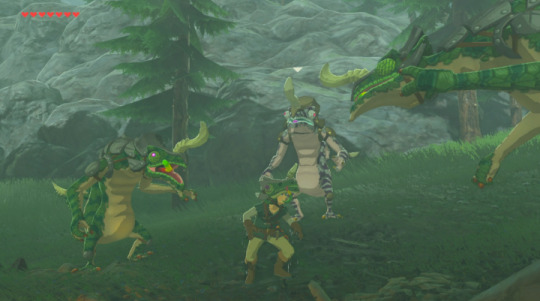
And I just...want to fight. A Darknut. One damn Darknut and have a cool sword fight. Or a Poe. Not another dAMN LIZALFOS. LET ME CLIMB TO THE TOP OF A MOUNTAIN AND FIND A WHOLE DUNGEON UP THERE.
I MISS.
HEART PIECES. AND UPGRADES.
AS REWARDS FOR EXCELLENT COMPLETION OF MINI-GAMES. IT INCITES. YOU TO REPLAY THEM.
AAAAAAAAAAAHHHHHHHHHHHHHHHHHHHHH
In summary, Breath of the Wild is excellent. But I’m a huge nerd and it’s clear that a lot of people who reviewed this game only went in for about 20 or so hours and didn’t complete it before passing final verdict. I hope Nintendo builds from this game’s strengths and learns it’s weaknesses.
35 notes
·
View notes
Text
camping out for twenty one pilots: a guide
hi! i’ve camped out for six of the seven twenty one pilots shows i’ve been to (ironically the one I didn’t camp out for was the last one), totaling 160 hours spent camping. for my first time camping i was twentieth in line, and for my most recent one, in new york, i was first. being first in line, it fell to me to organize the entire line for that show, so it was a good opportunity to master the practice of lining up. i’ve camped for shows in wisconsin, ohio, new york, and even for their saturday night live performance. i don’t mean to state this in a boastful way- i’ve gotten a few asks about camping out and figured i would put this experience to good use in making a guide for it. if you want to prepare for an upcoming show, or understand the line at your past show better, give it a read. i incorporated all of my experiences, my friends’ experiences, and things i’ve seen online (through an objective scope) into this guide, because no two shows have been the same, in terms of lining up. for the most part, camping comes down to luck: luck with the venue. it’s explained in detail under the readmore.
how the lines work
twenty one pilots has become notorious for shows that cause fans to line up days in advance. an indicator of this i’ve noticed is that an increasing number of venues are issuing public policies on lining up, mostly through twitter. many venues outright ban camping, giving a set time to arrive the morning of the show– but this is hardly the end of the story. many fans set up an unofficial line to camp earlier then technically permitted, and number themselves to stay organized. this is usually done off venue property but close nearby, and is organized by the first people to arrive. check social media in the days before the show to see if the venue has issued a policy on camping, or if anyone has already arrived at the venue. an important thing to note is the venue’s entrances, particularly if you’re the very first person in line. almost all venues have a separate entrance that they use for GA, apart from the main entrance. oftentimes it’s on the side of the venue. knowing where to line up will make sure other people don’t show up at the proper entrance and claim to be ahead of you. experiences with the unofficial line practice have varied, and it largely depends on the venue’s attitude towards it. for this tour, the east dates have honored the unofficial line system, and even accommodated it, while many west dates have been an absolute mess. Anaheim, in particular, was a highly dramatized event when the line system was such an issue that a lead member of the band crew (Mehdi) reprimanded people just for camping out. it’s critical to maintain a good relationship with venue staff when trying to line up. they’re just doing their job, and if camping on their property is prohibited, they have to enforce that. the key is compromise. when you arrive, try to seek out venue staff to figure out the line situation. it’s a good idea to talk to security, ideally the head of security- anything you explain to him is taken into account and disseminated to the rest of the security staff; persuade the leader and the entire staff will follow. try to get the venue staff to honor the unofficial line if one exists, to ensure that it is first-come-first-serve. sometimes they are willing to help keep it organized when it comes time to bring the unofficial line into the official one, other times they flat out deny any responsibility for the line until the day of the show, which usually ends badly for campers when people who arrive later attempt to get ahead of them by sprinting to the front. in short, make sure everyone is on the same page: campers, venue staff, and new arrivals especially.
arrival time
to get barricade you have to show up the night before at least now (unless you plan on pushing, which is an awful thing to do). for some shows it’s even earlier. for the past two tours i’ve been camping out for two nights per show because I like being at the front of the line and I have friends that make camping the best experience ever. generally speaking, california lines up the earliest. i’ve heard reports of people lining up 4-5 days in advance, probably because it’s warmer and more populated there. less populated states/cities will go 1-2 nights before, and larger cities around 2-3 nights. do research. ask people who have been to shows in your area. the trend so far is that every tour, lines start earlier and earlier, because the band’s popularity has yet to shrink.
what to bring
bring stuff so you don’t freeze in winter or get heat stroke in summer, which is a very real risk. camp with someone, the more people in your group the better- makes it both easier and funner. never go anywhere alone, especially at night! many venues are in dangerous neighborhoods. for most people dehydration is a very real risk. most people think “it won’t happen to me” and end up getting dragged out of the pit, which invalidates all the time they put into camping out, so don’t risk it and drink your darn water. some people bring tents, but that can be a hassle. good idea for larger groups though. blankets/sleeping bags/pillows are smart. portable chargers, snacks, changes of clothes, games to pass the time. you will need a car or hotel room or friend’s place located near the venue to store your belongings come showtime. i prefer the hotel even at shows i drive to because hotels mean showers, a bathroom at night (which WILL be a problem you’ll have to solve when you get to the venue- most bathrooms are closed at night!), and a bed for naps (provided it’s okay with other people in line). if you do get a room, don’t spend the whole night in there! i can’t tell you how many times people have gotten upset that “campers” just spent the night in their hotel room instead of in line. it’s happened at practically every show i’ve been to.
getting in line
make friends with the people around you in line. every line will have hostile people, whether they’re right or not, and it’s good to have allies who will support you in any line disputes. before doing anything involving leaving the line for more than a few minutes, check with the people behind you! if they’re upset at you and bold enough, they might just make a move to take your place and kick you to the back. make sure they’re okay with you leaving and don’t do anything to provoke them. it’s important that friends/family know where you are and what you’re doing. they will be your emergency contacts and explaining where you are is a major hassle during an emergency. talk to the people in line to figure out the bathroom situation, for both day and night.
before the show
once doors open, you’ll be at the barricade within 120 seconds and you’ll have to stand there for the next 5 or 6 hours. prepare for that. take care of your hydration, meals, and bathroom needs before the show or it will hurt. before the show you’ll have to put all your camping supplies away, around an hour before doors (earlier if the venue staff wants you to, which they sometimes do to compress the line). getting in, you’ll have to go through security. make sure your pockets are empty and bags ready for search. don’t rush through security because that has an inverse effect, taking you longer. have your ticket ready to be scanned. in arenas, you’re given a wristband after this that will let you onto the GA floor. when you get down there, show your wristband to be let in. don’t sprint, especially when at the front, because it causes everyone behind to follow suit. you will trip over a cable or stairs or whatever. it has happened plenty of times before and will happen to you if you’re reckless, not to mention how venue staff hates running and will stop you, which slows you down even worse than if you were simply walking. a brisk walk is more than enough. when i was first in line, i was fortunate enough to walk calmly to center barricade, turn around, and see no one else in the arena yet. so don’t freak out about getting barricade. you’re up front, and you will get there.
i hope this was helpful to you in some way. any questions not covered here can be sent to my ask box. feel free to add on to this, just remember that what happened at your show didn’t happen at every other show, so try to be unbiased, factual, and informative. stay safe when camping, and have a good time!
251 notes
·
View notes
Text
Voyager review.
This is long overdue (I was caught up with life stuff and had to stop liveblogging), but I actually finished watching Star Trek: Voyager last week.
Judging by the length of this post, HOLY SHIT, do I have a lot of feelings.
TL;DR: I’ll give it a 7/10.
My verdict:
Voyager had a number of truly extraordinary moments sprinkled among clusters of average to very low points.
I still loved Janeway a lot, even though there’s notable issues with her characterization. (Kate Mulgrew’s gr9)
Seven’s introduction gave the show a much-needed kick up the next level, but they ended up overdoing it imo.
Some characters are more developed than others, but I found the crew to be generally likeable.
Continuity? What’s that?
prime directive... prima directa... primal dialga... perma dry roof... pearl digestive... prophylactic dental... partial deposit... parking at disneyland...
I still enjoyed Voyager very much, but oh boy, did this show have many, many flaws. I also took it upon myself to read up on Voyager’s behind-the-scenes issues for context, and jfc, the production is even messier than the text. Put two and two together and it’s obvious why the show took the course it did.
I’ll go into detail behind the cut. It’s very long. Spoilers ahead :).
[CUT]
I’ll start with the negative points:
The ‘Endgame’ episode was... abrupt. It was still emotionally impactful, but it wasn’t the most graceful way to tie things up. Correct me if I’m wrong, but the show was given fair warning that the 7th season was going to be their last? If that’s the case, I expected more pre-finale plot development before this out-of-pocket Deus Ex Machina plot of future!Janeway pointing out a shortcut to the Alpha Quadrant. Or at least all the Borg encounter episodes could’ve added up to building Voyager’s path home. Endgame’s resolution is acceptable, but it really should’ve been spread out for the last half season.
The serial, episodic format of Voyager ultimately led to all the aspects in which it fell short. Particularly in continuity and character development. There were bad episodes, average, above average, and then there were GREAT ones.
But, it’s always Schrodinger’s cat on whether the next episode is going to be watchable or not, as well as which Janeway is going to show up.
At times, Janeway would be stringent when it comes to the prime directive. Other times she unquestionably abandons Starfleet protocol to be a good samaritan. One day she backs out of complicated situations in order to prevent any losses of life. Another day she’s adamant in achieving her goals even if means accruing some casualties on the way. She gave Harry shit for sleeping with a girl from an alien race without getting medically checked, but then makes out with Devore!Spencer Tracy-lite Bashyk next episode.
Over the course of the show, Voyager had many episodes that were forgettable. I found myself having to skip a lot of the holodeck fillers (Fair Haven is the worrrrrrssttt), some of the bottle episodes where the crew get first contact with alien races that would predictably betray them, and at times near the end, my fatigue of Seven and the Doctor can get me to tune out of their more unimpressive episodes.
But then there’s also episodes where they delve deep into character development, but they never acknowledge the character’s growth in any subsequent episodes. The better episodes of Voyager often feel like missed opportunities for more in-depth exploration. B’Elanna undergoing depression was a great plot point that they could have explored more. The episode they did on her about her self-hate for her Klingon half was great but how she came to terms with her Klingon identity felt incomplete. Her character always fascinated me, but I seriously needed more. #JusticeForB’ElannaTorres
The episode “Mortal Coil”, for example, explores Neelix coping with the loss of his belief system after experiencing death. HIs usual positive outlook was compromised because he realized there’s no heaven and he’s questioning the point of living. Neelix is far from my favourite, but I kind of relate to what he went through. Before the next episode started, it looked like he’s headed to a darker path. Perhaps this change will interfere with his approach to being the morale officer, or he’d don a more assertive aura in future eps. Then he’d be a more interesting character. But NOPE, next episode he’s back to his old sunny self. Missed. Opportunity.
I’m going to echo what I said in this post I made awhile back. I do love Seven’s character, I truly do, but the balanced family dynamic of the crew was special. She didn’t have trouble integrating into the cast, but she pretty much hijacked the show from then on. She’s a great, well-developed character but I found myself longing for the others to get as much depth as she did.
I just read up on the Jeri Ryan/Brannon Braga stuff, the beef between Mulgrew and Ryan, the writers willfully shortchanging the actors they don’t like (Beltran, Wang getting less focus episodes), the intense working conditions, and just... the general toxicity of the environment (not to mention Rick Berman’s an ass). I see how the behind the scenes conflicts could’ve influenced the show and now that’s just... really irresponsible.
Now, for the positives!
The writing of her character is flawed, but I thought Captain, *ahem* ADMIRAL Kathryn Janeway was a splendid captain. We wouldn’t know which Janeway showed up each episode, but I love all the versions lmao. Before I binged Voyager, I was already defensive of her from a symbolic standpoint, being the only female captain to lead a show and all. But it turns out that defensiveness was justified. Janeway is both strong, yet fragile. Authoritative, but warm. Adventurous and scientific, but can also get reclusive. She was overly curious, stubborn, and indecisive, but ultimately handled her woes with grace. She proudly demonstrates her iron will, but her empathy for others always prevailed. Her character arc took many paths and turns (intentional or not) but I enjoyed how the character was conducted as the leader of the ship. I felt a different affection she particularly shows to her crew that I don’t think other Trek captains ever did.
If anything, I have to credit Kate Mulgrew for masking the inconsistent writing quite well. Janeway came off as layered and multi-faceted instead of mischaracterized.
As for the rest of the cast: they each have their own quirks and they all helped prompt the dynamic of the team. A number of them fell flat towards the end, like Kim & Chakotay, (but I guess it was for the best because of the racist elements of the Chakotay character and Kim’s infantilization. I really wish the writers got more creative with them though.) But either way, all the chracters contributed to the crew in their own way. Each one of them did have a standout episode. They all took a while to find their footing at the beginning, but they all eventually grow into it.
Now, when Voyager has a great episode, it’s REALLY, REALLY GREAT.
By far my favourite episode in the entire show is the “Year of Hell”. There’s been plenty of episodes where the crew undertook mishaps but always came out unscathed. But in the “Year of Hell”, this conflict took the crew to dark, new places that really challenged their limits. They were plunged in a darker place of total despondence and desperation, where they got in each other’s nerves, they sacrificed things they love, and the situation tested their hope and will for survival. The desperate situation made for compelling interaction between the characters in how their dynamic changed after their morals were compromised. I also enjoy the laid back nature of Voyager, but I do wonder what it would’ve been like if the whole show had been like this?
Other favourites were:
Living Witness-- a poignant examination of the nuances behind historical remembrance. An issue that is still relevant today. At first I was going to be annoyed if the point of the story is to clear Voyager’s good name, but later on, The Doctor says that the obsolete Voyager’s reputation is irrelevant to the creating peace between the two factions. *cough*Japan downplaying wartime aggression to clear their name*cough*
Timeless-- just a well-done episode. Yes, once again, they dabble into alternate timelines, but this episode brings such emotional weight and splendidly tackles the issue of survivor’s guilt. Kim’s finest moment. Also, Geordi my king!
Deadlock-- Another space-time episode, but the duplicates really posed a formidable challenge to the crew. It was also a testament to their nobility and sacrifice.
Scorpion-- the game-changer for the show. Also, Seven’s first appearance!
Equinox-- again, this episode featured the crew encountering a real moral dilemma. One of the few episodes that treated the prime directive with a non-simplistic, nuanced approach.
Resolutions, The Chute - ‘cause I’m shipper trash.
Anyway, this was tiring to write. I’m thinking of taking a break from sci-fi shows for a while, then maybe I’ll rewatch TNG or BSG again. Voyager was the only Trek I haven’t watched chronologically and it was nice to witness ‘new’ Star Trek again. This is really long, but I spent over 120 hours watching this, sooooo...
6 notes
·
View notes
Text
Five Things You Should Consider to Plan the Best Tanzania Safari

When planning a safari trip to Tanzania , people think Serengeti and the Great Migration, but there are a couple more things to consider. It will help you get the most out of the experience while enjoying the most famous African natural wonder. How Much Time? Up to four days People often ask me how much time I should spend in Tanzania, and that is a complicated question to answer because it depends on the individual. It depends on your budget and what you like to see. I would recommend nothing less than a three-night safari focusing your time in one location. A three-night safari will often happen as a side trip, mixed with business while one is in the region and doesn't have much spare time. Four to Seven days Looking at four to seven nights will give you a bit more variety and you could even visit three different regions or parks to get a much better safari experience. Depending on your wishlist, one could also include Ngorongoro Crater with a Serengeti Safari without feeling like you are on a "Ferrari-safari" and be able to fit cultural experiences as well as a hot-air balloon safari. More than seven days Spending more than seven days opens up a whole list of possibilities and will be recommended if your budget and time allows. It is not always possible to allocate so much free time in one's busy "rat-race" lifestyle, but this is the way to go if you would like to replenish your soul. Spending more than seven days will allow you to experience the elephants at Tarangire National park, the Flamingos at Lake Manyara (both depending on the time of the year), a picnic lunch inside the Ngorongoro Crater, local village lunch at Mto Wa Mbo, traditional Masai village visits, finishing on a high note in the Serengeti seeing the Great Migration in action. One can even add a side trip at one of Zanzibar's various lodges and hotels to end your perfect African safari. What Would You Like to see Cultural experiences Tanzania is an extremely culture-rich country with over 120 different tribes, of which the Masai people are the most famous in the outside world. My recommendation is to get to know a couple of words in Swahili, which is one of the two official languages in Tanzania and is commonly used in the country. However, English will be great, and you wouldn't have any real problems communicating with the people. There is always someone that can translate if need be. Should you wish to mix some cultural experiences and get to know the people, then there are quite a few places where you can visit a traditional Masai village and get to know their history. Mto Wa Mbo is another excellent example of getting to see how the Tanzanian tribes live, and the locals will welcome you into their home where you can experience a traditional lunch. For those looking for a bit more, there is the local village tour in and amongst the banana plantation. These stops don't take that long and incorporate well in your travel itinerary, making it a pitstop en-route to your next destination. Serengeti The word Serengeti is synonymous with Tanzania and means "endless plains", quite the fitting name as it describes the Serengeti perfectly! The Serengeti is a massive National park, it spans for about 12 000 square miles, roughly the size of Belgium, and hosts the world's most famous natural wonder for the most of the year. It isn't straightforward to explain the emotions that one gets when seeing thousands and thousands of wildebeests and zebras, as far as the eye can see. The Southern Serengeti is best during the calving season, and the Northern Serengeti is best during the Mara river crossing when the wildebeest and zebra heads into the Masao Mara. The Central Serengeti is great year-round, and you are bound to see some big cats and other big-5 animals, no matter where the migration herds are located. I would recommend adding the Central Serengeti in your itinerary! Tarangire National Park & Lake Manyara National Park One of the lesser-known gems of Tanzania but worth your time! It should be considered if you like Elephants, Baobab trees, and Flamingoes. There are other species of animals in these regions, but the above will be the stars of the show. I've been to a couple of areas in Africa, including the Okavango Delta, and few places outside Botswana can compare elephant numbers like Tarangire National park. Lake Manyara is just right next to Tarangire National park and ties in well with the Ngorongoro crater into a safari circuit. You won't spend more than a couple of hours between Arusha, which is the central starting hub of the Tanzanian safari experience and the "main star" aka the Serengeti. Ngorongoro Crater Ngorongoro Crater is the world's largest inactive volcanic caldera and hosts its ecosystem with a wetland, forest, swamp, and open plains. The whole experience can be done as a day trip en-route and sits in-between Lake Manyara and the Serengeti. Private or Scheduled Group Safari Budget difference People often tell me that they either don't have a clue how much they can afford, and this is all new to them. Booking a safari trip to Tanzania for the first time can be confusing, and one doesn't always know what the total package includes. There are quite a few things that add up to the total cost, such as the vehicle, fuel, the guides accommodation, the guide's meals, and drinks, accommodation, meals, possible beverages, park fees, etc. In my experience, the animals don't know who spent what, and the animals will act and react the same regardless of where your accommodation is based. Pros of private In saying that you will get the same animals "on-show", there are private safaris where the total cost, as mentioned above, is shared by the number of people in the vehicle. So if you are only one couple, then the total cost will be split amongst two people. This is often the more expensive option but gives you the flexibility of choice, the choice of camps, the choice of routing and National parks that you would like to see, and the choice of how much time you would like to spend per sighting. Pros of scheduled - more basic and larger lodge style Scheduled safaris are great and allow a broader range of people to visit this beautiful country and to experience the "stars of the show" with your own eyes. One can't alter a group scheduled safaris itinerary, but often what happens is that the ground handler will negotiate a much better rate with the lodges because of continued business, which brings the total cost down, more money in your pocket. A typical safari vehicle can accommodate a maximum of about seven people. Hence, the groups aren't that big and a great idea for larger families that could occupy the entire vehicle at a group safari rate. Group safaris are also great for single travellers that have been trending for the last couple of years. You get to meet new like-minded people and possibly meet your future best friend on the safari. Main events on the Migration calendar I feel it is vital to mention a few facts about the Migration before continuing. The Great Migration happens the whole year-round, and the animals follow the rain that provides them with nutrition-rich grass to feed on. Predicting the weather is not an easy task, and notably, long term predictions are nearly impossible. Discover Africa has been collecting data over the last few years from our herd tracker website. We are running this initiative with local rangers and guests. Herd Tracker has given us valuable insights into the movements and helps us to try and give you the best possible chance to stay as close to the Migration as possible. Calving Season - January to March There are two significant events on the Migration calendar, in which the calving season is one. The Migration usually comes to a short halt in the Southern Serengeti close to Lake Ndutu, where the calving happens. With the calving comes the predators, which can cause some action. River Crossing - June to August The famous Mara river crossing happens around this time of the year, and people often think of the Migration as one big massive herd, which is not entirely true. The Great Migration is made up of 100's of smaller herds travelling in the same direction, and in some areas, you will find higher densities of herds. This is the reason why you will find that the "front runners" will cross the river a long time before the back end of the Migration cross the river. It is challenging to guarantee a river crossing sighting because people don't know when the animals are going to take the leap and decide when is the best time to cross. The animals could bunch up next to the river for days before crossing. Getting around Light Aircraft The two transport options on offer will be closed 4x4 vehicles and light aircraft transfers accompanied by the lodges open-air safari vehicles for the duration of your stay. I would recommend a mix of both to give you the best of both worlds. I've been privileged to experience both on a Tanzania safari , and it was fantastic to end the trip with a Light Aircraft flight, seeing the aerial view of what we experienced on the road towards the Northern Serengeti. A light Aircraft is an excellent option if you don't want to spend 2 - 4 hours on the road or if you only have limited time to spend on safari. Road transport My personal favourite will be the closed 4x4 vehicle with the pop-up roof. You get to see the smaller villages en-route, we even saw street performers along a dirt road between lake Manyara and Karatu, close to Ngorongoro Crater. The longest time we spend in the vehicle was about 4 hours from Ngorongoro Crater to the Southern Serengeti. Still, we stopped at a real traditional Masai village on the way, allowing us to stretch our legs and get to know the Masai culture firsthand by one of the Village Leader's sons. We also spend so much time with our guide that ends up being friends at the end of the safari, and your guide gets to know you, what you like, what animals you want to see, and what animals you haven't seen yet. All these small things add up to a great experience! There are other things to consider when planning your safari, such as booking in advance, the Migration is a worldwide favourite, and there are only so many camps and beds for people to stay at. I would be more than happy to share my knowledge and passion for this beautiful country, Called Tanzania, with you, and help you navigate through all the information. Tanzania should be on everyone's bucket list! Till next time... Matthys Tanzania Safari
0 notes
Text
Australia Travel Tips: 14 Things You Should Know in 2020
After I first touched down in Australia, I didn’t know what to anticipate. I had a one-way ticket, a Working Vacation visa, and two nights booked in a Sydney hostel. Regardless of having learn my Lonely Planet from finish to finish, and regardless of realizing precisely what I needed to do, I felt like there have been a whole lot of gaps within the info I used to be capable of finding. I didn’t know what I may do.
I grossly over- and under-estimated a superb variety of issues. From budgets to transportation to journey jobs to booze, there was a whole lot of lacking info. Granted, I used to be new to backpacking, however each nation has its nuances.
These are 14 Australia journey suggestions I want I knew earlier than I went.
1. Be Reasonable About What You Can See
We each know Australia is huge, however many vacationers underestimate simply how monumental the nation really is.
Few notice that Australia is definitely about the identical measurement because the continental USA, which implies flying from Sydney to Perth is concerning the equal of flying from New York to LA. New South Wales is similar measurement as Texas and Western Australia is an identical measurement to all of Western Europe (right here’s proof).
Briefly, there’s no manner you’re going to see Sydney, the Nice Barrier Reef, Perth, and that huge purple rock all in a two-week journey.
Australia is simply too huge to be overly formidable with the itinerary. Even the well-known backpacker East Coast wants at the very least couple of months—I traveled from Sydney to Cairns in two months and it felt hurried. With a lot to see it’s inevitable that almost all Australia journeys are rushed, which actually doesn’t go well with the nation’s chilled ambiance.
It will probably really feel annoying to overlook out on sure locations, but it surely’s vital to be reasonable about what you may see. You’re higher off slowing down and having fun with your self reasonably than speeding round making an attempt to see all the pieces directly.
Kangaroo Island shoreline in South Australia
2. There are Journey Businesses on Each Nook
In Australia, there may be a whole lot of competitors for your enterprise. The vacationer infrastructure is very nicely put-together, which implies touring across the nation is definitely very straightforward. There are journey companies in each city and in fashionable backpacker cities, it seems like they’re on each avenue nook. Most hostels have reserving desks as nicely.
Whereas it may be tempting to pre-book for peace of thoughts, you may usually get significantly better offers when you arrive. Plus, you may hold a extra versatile itinerary, which is useful once you make new associates at a hostel and wish to change your plans.
TIP: Don’t settle for the primary worth you’re given. Get a quote at one journey agent, then ask one other firm to beat it. All these journey companies earn cash by way of fee (normally 20 or 25%), so that they’re normally fairly fast to knock 10% off the worth in case you ask them to!
3. Save 10% at Hostels With a YHA Membership
With such a powerful journey infrastructure in place, Australia is dwelling to a number of the finest hostels on this planet, solely matched in high quality to hostels in Western Europe. YHA (Youth Hostelling Affiliation) Australia has a community of hostels everywhere in the nation, that are personally vetted, backed with their stamp of approval, and accepted into their community. While you keep at a YHA, you’re assured a sure normal of lodging and amenities.
A YHA membership saves you at the very least 10% on YHA lodging, plus reductions on over 700 excursions and sights. You can even purchase ePACKS, a bundle of nights at a pre-approved price, that you should utilize at any hostel within the nation, no matter what their normal price is.
4. The Greatest Journey Expense is Beer
Limiting your alcohol spend is one of the simplest ways to do and see extra of Australia. It’s troublesome recommendation—belief me, I do know—however with a bottle of beer costing someplace within the neighborhood of $8-$10 AUD, a couple of beers each night can blow most budgets, which implies much less cash for cool excursions.
On a tighter funds, you could possibly realistically journey in Australia on $70-$100 USD per day. You’ll be largely tenting (with the odd night time in a dorm), cooking all of your meals, fastidiously deciding on the paid sights, and avoiding nights out.
With $120-$150 USD per day, you can expertise most of the better of Australia. This funds consists of sleeping in hostels and low-cost lodging, having the odd restaurant meal, plus incorporating excursions and excursions.
Simply keep in mind that beer from the bottle outlets is way cheaper than beer from the bars and Australia isn’t brief on good locations to sit down and have a drink.
5. Sure, You Want a Visa to Journey to Australia
When you plan to go to Asia or Africa, it appears apparent that you simply’ll want a visa for a lot of nations. However since Australia is one other Western English-speaking nation, many vacationers don’t even test. And belief me—you don’t wish to get turned away on the border. It’s a protracted flight dwelling.
Until you’re from New Zealand, you’ll want to prepare an Australian visa prematurely.
Thankfully, they’ve a very simple digital visa system, aka Digital Journey Authority (ETA). The visa is electronically linked to your passport and should be utilized for prematurely of your arrival. It means that you can keep in Australia for as much as three months, and it solely prices AUD$20 in case you’re American or Canadian, free in case you’re an EU citizen.
Apply on-line at the Australian Immigration web site and you must have approval in two to 3 working days.
One requirement of the ETA (and it is a huge one) is to have a return or outbound flight. That is normally checked once you board your flight to Australia, but it surely’s undoubtedly checked once you arrive. Even in case you’re planning an extended journey and you propose to use for a visa extension, it’s important to have an outbound flight inside three months of your arrival.
Huge tip proper right here: If proof of an onward flight is an issue, ebook an outbound ticket direct with an airline (reasonably than a journey agent or flight aggregator) instantly earlier than you depart. Since airways are required to supply refunds inside 24 hours, simply name and cancel your reserving when you land. However, earlier than you ebook, be sure to verify the phrases of cancellation to make sure you can obtain a 100% no-penalty refund. Then it doesn’t price something however a telephone name to cancel the flight.
A typical Australian sundown
6. Australia is the Best Place to Get a Working Vacation Visa
Australia is a simple journey in case you’re searching for a primary huge journey away from dwelling (or perhaps a second or third!). Except New Zealand, no different place on this planet is as straightforward to acquire a Working Vacation Visa. I spent my first yr away from dwelling in Australia touring and working in bars and eating places to assist my travels.
The Working Vacation visa should be obtained prematurely and also you’ll have to enter Australia earlier than you flip 31. Whereas the visa means that you can work, you’re solely technically allowed to stick with one employer for six months, which implies you’ll want at the very least two jobs for the entire yr. It’s not an answer for locating everlasting work—simply fast and enjoyable jobs on the street.
Individuals get just one one-year Working Vacation Visa, however Canadians and EU residents can get a one-year working vacation extension if they’ve achieved at the very least three months of farm work or fruit selecting.
Which brings us to our subsequent level…
7. Fruit Choosing is Seasonal and Regional—Do Your Analysis
Probably the most ample work for foreigners is fruit selecting. It’s a tricky job and the hours are lengthy, but it surely’s nicely paid and also you spend your days within the solar. Plus, there’s an ideal environment between employees.
Most individuals are doing it for one in every of three causes: the expertise, the money, or the visa. Once more, fruit selecting isn’t a everlasting resolution, but it surely’s an finish to a method.
That being mentioned, fruit selecting is fully depending on the harvest time. It’s no use arriving in Margaret River for the surf season anticipating to search out work on a farm as a result of their grape-picking season is at a totally time of yr. You’ll haven’t any downside getting a job in Queensland in June and July, notably on the sugarcane plantations, however in March, nicely, good luck.
So do your analysis. Fruit selecting is all about being in the appropriate place on the proper time.
Shute Harbour, Australia
8. Take A Hop-On Hop-Off Bus All of the Approach Up the East Coast
Whereas Australia has virtually 20,000 miles of shoreline, it’s the two,000-odd miles between Sydney and Cairns that obtain the majority of the guests. With the Nice Barrier Reef operating alongside a single coastal freeway, and the locations being a mixture of cute fishing villages and brazen occasion cities, the East Coast is an exuberant and numerous journey.
Touring the East Coast is Australia’s iconic backpacker journey, with dozens of potential stops alongside the way in which—you’ll see pristine seashores, meet vacationers from around the globe, and there shall be heaps and many partying.
There are many methods to do it however by far the best (and doubtless hottest) is a hop-on-hop-off bus ticket from Greyhound. You possibly can cease at whichever locations you select, and also you’ll make loads of new associates on the bus.
9. Municipal BBQ’s Are a Nice Place to Save Cash and Meet the Locals
Each city in Australia has at the very least one municipal barbecue floor, typically with a chief location in a park overlooking the ocean. You couldn’t beat that view at a Michelin-star restaurant!
Every BBQ space has a sequence of enormous gasoline plates which can be free for public use. They’ve an ideal social environment, so carry a couple of new associates and also you’re certain to satisfy some extra. Cooking your individual meals reduces a big proportion of prices, and cooking at these BBQ grounds feels extra like consuming out than cooking in a hostel kitchen.
10. Whitehaven Seaside is the Most Stunning Seaside You Will Ever See
There are doubtless many locations in your Australia itinerary, and a few of them you’ll need to sacrifice for the sake of time, however the one you undoubtedly don’t wish to miss is Whitehaven Seaside.
Whitehaven Seaside is a five-mile stretch of rippling white sand on Whitsunday Island. It’s surrounded by the clearest turquoise waters you could possibly ever think about and the sand is so nice it squeaks beneath your toes.
The Whitsunday Islands are accessible by boat from Airlie Seaside (keep on the Airlie Seaside YHA) and by far one of the simplest ways to go to is on a multi-day cruise. These two or three-night voyages are tailor-made in direction of backpackers—you’ll go to a variety of islands, with Whitehaven being the spotlight. The sand is so pure that it’s really unlawful to take away any of it!
The beautiful Whitehaven Seaside within the Whitsunday Islands
11. Goon Will Save Your Pockets However Destroy Your Abdomen
With beer costing nearly all of your journey funds, there must be a greater manner. Effectively don’t fear, there may be. The phrase “higher,” nonetheless, may want some redefining.
The one inexpensive alcohol in Australia is boxed wine, additionally affectionately often called goon. One 3.5-liter field is similar worth as, if not cheaper than, a single beer in a bar.
When you’re getting ready for an enormous weekend on Fraser Island and even only a sport of playing cards within the hostel with some new associates, goon is the reply to your issues. However be careful—you haven’t had an actual hangover till you’ve had an evening out on goon.
12. Uluru Is Extra Than One Huge Rock—Don’t Miss It
It sounds weird—touring into the center of nowhere for a rock—however what a rock it’s! Uluru could be the largest most redolent rock on the planet, shifting by way of a kaleidoscope of colours because the solar falls throughout the sky.
Uluru, or Ayer’s Rock to make use of the colonial title, is the iconic picture of Australia. Besides it’s probably not Australian—it’s proudly Aboriginal.
However there’s greater than only one rock. Few individuals are conscious that 26 extra big purple rocks lie simply throughout from Uluru. The domes of Kata Tjuta are equally vital to Aboriginal heritage, and so they’re simply as a lot of a spectacle. They really rise increased than Uluru.
You could go to Australia’s purple middle for Uluru, however you’ll in all probability discover that Kata Tjuta is extra spectacular, each aesthetically and spiritually.
Getting into Kata Tjuta within the outback of Australia
13. Lease a Campervan to Discover Wild Australia
Australia is a large journey. This can be a place of wilderness and hinterland, a dry and barren land that evokes all of the impressions of the desert and the bush. Nevertheless it’s not simply concerning the outback, both—there are virtually 20,000 miles of coast to find.
I’m an enormous believer within the journey being as vital because the vacation spot. In most of Australia, the expertise is all about what you see on the way in which. Freedom and adaptability make a campervan a good way to discover. Your mattress and kitchen are in your car, so you may cease and go anyplace.
Hiring a camper and touring wild Australia is an actual journey dream. It’s surprisingly easy and the roads are awash with backpackers rumbling down the highways of their rented and painted campers.
TIP: When you’re planning to hire a campervan, the Camps 10 guidebook shall be your finest funding. It particulars all of the locations you may safely park and make use of campsite amenities. Camps Eight is a large ebook that accommodates just about all the general public and business tenting and campervan websites in Australia.
14. Touring to the West Coast is ALWAYS Price It
The West Coast is wild and unspoiled, far off the overwhelmed observe when in comparison with the East Coast. This aspect of the nation has all the time remained extra undeveloped and uncultivated.
State capital Perth is a gleaming but serene base which runs on a rhythm of work exhausting and play-much-harder. From right here the journey runs in two instructions: north, to abandoned seashores and achingly lovely shoreline, or south, to abandoned seashores and an achingly lovely shoreline!
When evaluating the East and West coasts, some want the unparalleled coastal splendor of the West, whereas others lean in direction of the larger variety of locations in the East. It’s true that the West Coast is slightly bit out of the way in which, but it surely’s undoubtedly value it.
What’s your finest tip for touring in Australia? Tell us within the feedback under!
READ NEXT: The 10 Finest Backpacker Cities in Australia
source http://cheaprtravels.com/australia-travel-tips-14-things-you-should-know-in-2020/
0 notes
Text
Things to Consider Before Hiring a Cleaning Service
Is Hiring a Home Cleaning Service or Maid Worth It? – Pros & Cons
My wife and I carefully calculated the cost of cat ownership before we took in our first stray. Our calculation wasn’t perfect, though. We failed to account for at least one hidden cost of owning pets: cleaning bills.
Now that we have multiple cats, our home is far dirtier than it used to be, and it gets dirty quicker. As renters, we spent valuable time and a considerable amount of money on weekly once-overs and monthly deep cleans. I devoted hundreds of hours over the better part of a decade to mopping wood floors in a succession of apartments.Sign up for an account at Simple by 7/31/19 4:59 PM PT and get up to a $500 bonus and 2.02% APY (with qualified activities).
Unfortunately, this wasn’t always enough. Poor pet hygiene contributed to a substantial reduction in our security deposit refund at our last rental property. Now that we own our home, we don’t have to worry about keeping the landlord happy – but that doesn’t mean we’re willing to tolerate mats of hair in every corner and fine layers of litter on the floor.
As our lives get busier and our household budget grows, we’ve relaxed our old “no professional cleanings” rule. We now invite a cleaning service into our home for two to three hours at least once per month. Although I’m still not entirely comfortable with the cost, I have to admit that our house is cleaner for it.
If you’re unable or unwilling to keep your home as clean as you’d like, perhaps a hired home cleaning service from Handy.com is in your future too. Here’s what you need to know to decide whether it’s right for you.
Things to Consider Before Hiring a Cleaning Service
As you weigh whether to hire a home cleaning service, consider these factors.
1. Your Household Budget
According to HomeAdvisor’s estimate, U.S. cleaning companies charge $50 to $90 per hour, on average. Even the most efficient cleaning team working through a modest-sized residence is likely to take an hour to complete its work. If your budget can’t bear an extra $50 to $90 hit at least once per month, regular professional cleanings may not be in the cards.
Independent cleaners are cheaper, though my research suggests HomeAdvisor’s estimated $9-per-hour minimum is wildly optimistic. Expect to pay a single independent cleaner at least $20 per hour if they provide their own cleaning supplies and perhaps $15 per hour if you provide your own.
Solo cleaners take longer to complete their work than two- or three-person professional teams, so the price difference likely won’t be that stark. Still, cleaners not affiliated with hierarchical cleaning companies can better accommodate tight budgets – though budgets with very little leeway might not have room for any hired cleaning help at all.
Pro tip: If you haven’t set up a budget for you or your family, sign up today for Personal Capital. Once you connect your debit and credit accounts you will have a clear picture of where your money is being spent each month.
2. Your Home’s Size
Professional cleaning costs increase in proportion to residence size. According to HomeAdvisor, the typical single-family home costs $130 to clean. The American Enterprise Institute (AEI) pegged the median U.S. house at 2,467 square feet in 2015. A more modest home might cost $100 or less to clean, while a massive McMansion could cost $200 or more.
3. Your Cleaning Requirements
The numbers above are rough averages. Your personal cleaning requirements and preferences will determine where your actual cleaning costs fall. Factors that might affect your cleaning requirements include:
Your Cleanliness Tolerance. Do you demand a spotless home, or are you OK with some dust, grit, and grime?
Your Lifestyle. Do you cook full meals every night and frequently host guests? Do you treat your home like a museum? Or do you fall somewhere in between?
Your Family Size and Composition. Do kids and pets account for more than their fair share of the mess?
Your Home’s Active Areas. Do you rarely use certain rooms, or is your entire home lived-in?
Your Expectations For Cleaning Staff. Do you expect cleanings to be basic once-overs – vacuuming, dusting, mopping, and freshening, with special attention paid to the kitchen and bathrooms – or thorough deep cleans?
Longer, detail-oriented cleanings that cover the entire house will cost more than lower-key cleanings that skip lesser-used areas.
4. The Value of Your Time
How valuable is your time?
You can ask this question literally: Is your hourly household income higher than what you’d pay a cleaning service?
A more abstract way to frame it would be: Is it worth your while to devote the time necessary to clean your home to your standards on a regular basis?
Either way, this is a personal question. When I was living alone and working low-wage jobs, DIY cleaning was a no-brainer. These days, the dollars-and-cents calculation is a closer call, but I’m personally less inclined to take several hours out of my week to maintain an orderly house (or perhaps I’m just getting old). Your calculation might differ.
5. Your Family’s Schedule
Professional cleaning is disruptive. If you don’t mind hanging out around the house while one or more cleaning staff mill about, running vacuums and kicking up dust, this won’t be an issue. If you’d prefer to be out of your cleaning team’s hair, though, you’ll need to schedule cleanings when you’re at work or can otherwise be out of the house. If your cleaning service doesn’t let you schedule at precise times – as is often the case – then you’ll need to choose a date on which you’re reasonably confident you can be out of the house.
In households with at least one work-from-home or stay-at-home parent, scheduling is a real issue. My wife and I both work full-time, but I work from home much of the time, and the cleaning service we’ve been using occasionally schedules visits when we’re at home. In our small older home, that’s not really tenable, so we escape to a coffee shop or park if the weather’s nice.
6. DIY Cleaning Tolerance & Skill
If you enjoy – or, at least, don’t mind – cleaning the house, more power to you. As long as you can find time to keep pace with your home’s cleaning needs and meet your co-residents’ expectations, why would you pay someone else to do it for you?
Make sure your cleaning expectations are realistic, though. Budget one hour a month for something that requires more like two hours per week, and you’re set up to fail. Likewise, if you’re not keen on using step ladders to dust high places or scrubbing out caked-on cooking grease, you might want to rethink your DIY cleaning plan.
Cleaning Service Types & Costs
In our search for a professional home cleaning service, my wife and I considered three distinct options.
1. Full-Service Cleaning Companies
These are legitimate enterprises that employ multiple teams of two or more cleaning professionals. Some national cleaning companies operate local franchises; others are independently owned entities that have grown into regional service providers. Either way, your regular point of contact is generally an account manager or office-based crew supervisor.
Cost of Full-Service Cleaning Companies
Full-service cleaning companies generally cost more than independent cleaners and gig workers. However, they’re often better at what they do and more efficient to boot.
According to HomeAdvisor’s estimates, full-service cleaning companies charge anywhere from $50 to $90 per hour, or $90 flat per 1,000 square feet. This range is lower by Care.com’s estimate: $25 to $35 per hour, though it’s not clear whether this assumes only one cleaning person on the job.
Our experience tracks with HomeAdvisor’s estimates. My wife and I got quotes for our 1,400 square foot house from a handful of professional cleaning services in Minneapolis. No biweekly quotes came in under $120, and the high estimate was around $160. We settled on a company that quoted us about $145 per biweekly cleaning because my wife’s employer had a $20-off-per-cleaning deal with them, cutting our net per-cleaning cost to about $125.
Besides home size, many factors may influence your professional cleaning estimate. The most notable include:
Location. Expect higher prices in major metropolitan areas with higher living costs. You’re almost certain to pay more for an equivalent service in San Francisco than in, say, Abilene, Texas.
Frequency. Professional cleaning services almost always offer frequency discounts. You’ll pay less per visit when you opt for weekly cleanings over monthly cleanings, even if your total cleaning cost is higher with the former. Our monthly cleaning estimates were higher, ranging from $140 to $180. One-off cleaning estimates were higher still; the service we eventually selected wanted $250 for a one-time cleaning session.
Bathroom Count. Bathrooms require more intensive cleanings than most other rooms. If your home has an unusually high number of bathrooms for its size, your estimate may come in higher than you expect.
Pets. Expect professional services to factor the number and type of pets into your estimate. All of our quotes accounted for our three cats.
Eco-Friendly Products. Cleaning services that use gentler or eco-friendly cleaning products generally charge a premium for it. You’ll want to have a detailed conversation about what each candidate company’s eco-friendly cleaning program entails.
Add-On Services. Most professional cleaners charge extra for add-on services such as refrigerator cleanings, decorative wood polishing, oven cleanings, and whole-house deep cleanings.
Special Needs. Professional cleaners may charge more for special requests or accommodations – for instance, dusting the area around an antique china display or reaching upper corners in rooms with unusually tall ceilings.
Pros of Full-Service Cleaning Companies
Pre-Vetted Employees. Full-service cleaning companies vet prospective employees before they hire them so that you don’t have to. Not all hiring practices are equal, though, so ask your company contact if this is a concern.
Faster Than Independent Cleaners. Professional cleaners usually work in teams of two or three, and perhaps more in larger homes. As the old saying goes, many hands make light work.
Potential for Better Work Than Independent and Gig-Based Cleaners. Professional companies’ training protocols tend to be more rigorous – or, at least, better standardized – than those of independent or gig-based cleaners, who may be self-taught or rely on prior professional experience. Professional companies are also more likely to act on customers’ complaints about shoddy or inconsistent work.
Cons of Full-Service Cleaning Companies
Costlier Than Independent or Gig-Based Cleaners. Full-service cleaning companies are almost invariably more expensive than solo cleaners. We’ll explore this further in the following sections.
Add-On Services May Add Up Quickly. Professional cleaning companies tend to limit the parameters of standard cleanings to “basic” services such as cleaning floors, vacuuming rugs and carpets, dusting furniture, freshening bathrooms, and wiping kitchen counter surfaces. Other services, such as refrigerator cleaning and detailing upholstery, often cost extra. Our professional cleaning company charges $25 to deep clean a refrigerator, for instance.
2. Independent Cleaning Professionals
These are solopreneurs or small businesses built by and around an individual or small team of cleaning professionals. Your regular point of contact is usually the senior cleaning person, who’s also likely to be the business’s owner. Some independent professionals have their own websites, but plenty use social media (usually Facebook) or third-party platforms (such as Thumbtack, Angie’s List, and Craigslist) to market their services.
Independent cleaning professionals tend to be cheaper than full-service companies and may also be easier to work with. The onus is on the customer to vet prospective cleaners, though, and even then, quality and efficiency might not live up to expectations.
Cost of Independent Cleaners
Independent cleaners generally cost less than full-service cleaning companies. How much less is the question.
In late 2018, I surveyed Craigslist cleaning service ads in New York, Chicago, and Los Angeles. Per-hour pricing started around $15 (though pricing this low was rare) and topped out above $40, with occasional new-customer discounts pushing down the final price. Flat-fee cleanings started around $50 for three rooms and went up from there. Independent cleaning teams, who were often couples, charged more, though not always twice as much.
Pros of Independent Cleaners
Lower Cost Than Cleaning Companies. As noted, independent cleaners, especially solo types, usually cost less than pros. If paying as little as possible is your top priority, this is the way to go.
Potential for Greater Flexibility. Independent cleaners may be willing to include for free some or all of the add-ons for which professional companies tend to charge. If not, they may be amenable to a more customer-friendly pricing structure – for instance, simply adding the time spent on add-ons to the hourly total, rather than charging a flat fee that works out to a higher hourly rate.
Better Negotiating Power for Customers. You may have better luck negotiating with independent cleaners, particularly if you promise steady work. On the other hand, independents may operate on tight margins that limit their negotiating power.
The Same Person Cleans Every Time. When you work with the same independent cleaner or cleaning team every time, you’re more likely to develop a close working relationship with them. For scheduling reasons, full-service companies are unlikely to send the same cleaners to your house every time, unless that’s part of their value proposition.
Cons of Independent Cleaners
Vetting Falls to the Customer. The onus of vetting an independent cleaner falls squarely on the customer. Sure, you can check reviews and feedback on Angie’s List and HomeAdvisor, and you should always ask for references (more on that below), but that takes time. So does confirming that the cleaner is fully insured and running a background check, which you should do with any domestic worker.
Quality May Suffer. Independent cleaners may not offer the same quality guarantees as full-service companies. Short of terminating your relationship with the cleaner or unilaterally demanding they fix the issue without additional compensation, you may have little recourse to redress work that fails to meet your expectations.
Slower Than Full-Service Companies. Single-person cleaning teams can’t work as quickly as multi-person teams. Plus, full-service companies often hew to efficient, well-defined processes that get them out the door faster without impacting work quality.
Scheduling May Be a Challenge. If your independent cleaner already has a full client load, finding time for a recurring appointment that works for the both of you might be challenging.
0 notes
Text
Cinderella is an incredibly well-known story: a poor girl gets stuck living with her awful stepmother and stepsisters who treat her like a maid until one day she wows the prince at a masquerade ball and they live happily ever after. But what if Cinderella just wanted to escape, or she wanted to take back the home that was left to her stepmother and make it her own? What if the stepmother had her reasons for being awful, and the stepsisters did as well?
Cinders is a visual novel that allows players to explore these possibilities and more. Choose your own fate and chase your dreams, but be careful you don’t turn out just as rotten as your stepmother… or worse!
Title: Cinders Developer: MoaCube / Crunching Koalas Publisher: Crunching Koalas Platform: Nintendo Switch Game Version: Final Review Copy: Provided by publisher Interface: Handheld Switch console Available on Switch and Steam
Cinders is a witty young woman living with an overbearing stepmother and her two daughters, as if she was reenacting a certain well-known fairy tale. But unlike its protagonist, Cinders is not afraid of taking fate into her own hands. Even if it means breaking the rules…
The game takes a look at four women and what made them who they are. It’s a story about freedom, dreams, sisterhood, and finding your own Happily Ever After that may not exactly agree with the stale morals of classic fairytales.
With multiple endings, 120 decision points, and over 300 choices, Cinders gives you total control over the main character’s personality and how her story unfolds.
I love story-driven games, but I’d never played a visual novel until Cinders (not counting Utawarerumono: Mask of Deception, but I never want to think about that game again). I loved the idea of taking a very basic, simple fairytale and expanding upon it, and I figured it would be a great starting point into the world of visual novels. Heck, my “day job” is as a book reviewer, so combining gaming and books sounded like a dream come true.
Cinders ended up being pretty much exactly what I expected, but slightly better in almost every way. The game begins a week before the prince’s ball, but Cinders doesn’t know anything about that yet. Instead, her life is pretty much exactly as you’d expect it: she cooks, she cleans, and she gets berated, insulted, and mocked. Heck, even her name is a mockery of her existence. In fact, the explanation of the title was one of my favorite things about the game: she was nicknamed Cinders by her father because of the color of her hair, but her new family decided that it would be funny if she lived amongst the cinders in their home.
Despite her crappy existence, you’re given choices of how to interact with your family and what to do right from the start. You can treat your stepsisters just as badly as they treat you and rebel against your stepmother’s wishes, or you can suck it up and be the better person. There are additional, unique characters added to the story as well, such as a childhood friend who has become a merchant, a “witch” with a mysterious link to your family, and the prince’s right-hand man with an unshakable sense of duty. These characters have some real depth to them, and you’ll only get to see a little of that depth with each playthrough, depending on your choices.
The gameplay of Cinders is incredibly straightforward: you read dialogue, you get presented with choices, and you make said choices. That’s basically it! There’s no movement (aside from selecting from a map at specified moments), there are no puzzles (aside from figuring out how to get the endings you want), and there are no minigames to play. You don’t have to worry about stats or inventory or anything aside from choices, and you’re given an unlimited amount of time to make each choice. That isn’t to say the game is simple by any means; according to the developers, there are 155,000 words in the game, 135 scenes, and 120 choices to make. The game contains 50 profile variables to track how you relate to different characters and what kind of ending you’ll get. None of this is voiced, mind you, but I’d say that’s fair given how many lines of dialogue there are. I play the vast majority of my games muted anyway, and I read far faster than people speak, so I really didn’t feel like I was missing out on anything.
The first playthrough took a bit over 3 hours, but there was still loads to do. In fact, I spent about as much time with subsequent playthroughs as I did with the first, despite my heavy use of skip mode that allows players to get through a run in less than half an hour. Skip mode is a brilliant feature, and it’s one I almost missed entirely. Pressing the skip mode button sets things in fast forward, automatically continuing on until you exit skip mode, you’re given a choice to make, or you’re presented with dialogue you haven’t seen yet. This is amazing since there are four completely different endings to unlock, and when you include all of the potential possibilities of each ending, there are over 300! For example, if you end up with the fairytale ending (as queen), you can be one of four types of queens, you can have one of four love interests (you heard right, being married to the prince doesn’t mean he’s necessarily the one you love, or that he loves you!), and you can have one of four advisers (including none at all). These are all decided by the choices you make, and every time you play through the game you unlock those individual attributes in the Endings section. As you unlock more, you can mix and match them, although you’ll only see the last several screens of the ending if you make up an ending this way. The game shows you what percentage of the variants are found, and completionists will be incredibly busy unlocking them all. With all of my experimenting and messing around, I’ve only found about 60% of all of the variants, and it would’ve taken me far longer to figure out the fourth type of ending without help from the developer’s wiki. Without spoiling anything, I really wish there was a fifth major type of ending though. There’s a specific element in the game that seemed like it should have far bigger repercussions, but instead, it has minimal effect on the story. This would be a big deal if the other endings weren’t so terrific; the slightest changes in endings could lead to learning more about the world of Cinders. I was frequently blown away that the 5th, 7th, 10th, etc. times I played through the game I was still finding out more about various characters and seeing people in a new light.
I loved the themes Cinders explores. For one, the concept of choice itself is shown not only for Cinders (as you can see in the image above) but for everyone else in her life. The whole premise of Cinderella is that the titular heroine is trapped, unable to live her own life until magic intervenes. Even then, how does the story end? She marries a prince she knows almost nothing about, all to escape her former life. But in Cinders, you’re able to choose from all sorts of possibilities, and merely the fact that Cinders is making choices for herself is miraculous to her. But that’s the thing about starting to make choices for yourself: when you feel trapped for so long, every choice seems better than your current life, no matter where it leads. Who hasn’t blown a bunch of money after getting their first job, or eaten way more than they should the first time they have spending money at a fast food place? For Cinders, there are plenty of bad choices too. Then there are the other characters, who have gotten exactly where they are in life due to the choices they’ve made, or the lack thereof. Numerous characters are doing what their parents did, and feel just as trapped or indebted to their families as Cinders does, although they find themselves happier about it because of their attitudes. Even Cinders’ stepmother has made choices for reasons that make more and more sense as you discover her secrets, although she could still be less of a jerk.
The game does a terrific job with other topics and themes as well. The writers make light of the idea of Cinders settling down with the prince without really knowing anything about him, among other things. I appreciated the way that nearly every character is likable, even the ones that shouldn’t be. One of Cinders’ stepsisters, for example, is as sarcastic and bitter as I’d be in her position. The romanceable characters are likable, cool dudes, and I personally think Cinders would be happy with any of them (depending on how you play it). The “fairytale ending” of becoming queen is even deeper than just fairytale love, and if you play things wrong (or right, depending on your point of view) you can take control of the entire kingdom with an iron fist.
Cinders is terrific for fans of visual novels or “mature fairytales”, and folks who love twists on stories they already know well will especially get a kick out of it. However, this doesn’t limit who can enjoy the game – while the developers call this “a mature take on Cinderella,” it has a teen rating for a reason. While some adult things can happen, there are no sordid details and things never get any kind of gory or overly naughty. But if you’re the type of person who skips through dialogue, you’re definitely in the wrong place.
#gallery-0-5 { margin: auto; } #gallery-0-5 .gallery-item { float: left; margin-top: 10px; text-align: center; width: 25%; } #gallery-0-5 img { border: 2px solid #cfcfcf; } #gallery-0-5 .gallery-caption { margin-left: 0; } /* see gallery_shortcode() in wp-includes/media.php */
Cinders from #indiedev @TomGrochowiak and @CrunchingKoalas is an #indiegame visual novel where you help Cinderella make her own fate, for good or bad, with the prince or not. Check out our review! Cinderella is an incredibly well-known story: a poor girl gets stuck living with her awful stepmother and stepsisters who treat her like a maid until one day she wows the prince at a masquerade ball and they live happily ever after.
#Cinderella#Cinders#Crunching Koalas#fairytale#Mac#MoaCube#Nintendo Switch#pc#Steam#story#Story Driven#Switch#Visual Novel#Windows
1 note
·
View note
Text
Dobber Ramblings: Day Two of the NHL Playoffs; Gusev; Defence Scoring – April 12
There may be reinforcements on the way for Vegas as Nikita Gusev, the 26-year old Russian who was traded to the Golden Knights by Tampa Bay as part of the package to draft Jason Garrison in the expansion draft, could be in Vegas soon.
You can read Gusev’s Dobber Prospects profile here.
Nothing is a done deal yet. Gusev is under contract in the KHL through the end of the month, which means some negotiating will need to be completed, and the Russian Federation has recalled him ahead of the 2019 World Championships, which is another hurdle. Then he has to actually make his way to Vegas and suit up. All the same, it would be exciting to see him in the playoffs.
*
Just a small thing, but Ilya Samsonov, Washington’s top goalie prospect, was on the ice for morning skate on Thursday. Barring catastrophic injuries, he won’t get into game action, but it’s still pretty cool to see him on NHL ice nonetheless.
*
Just for a bit of fun, there was an article over at The Athletic from Sean McIndoe about the “what ifs” of the draft lottery. These are games involving teams near or around the picks that would end up in the top-3 and how things would be different if small little quirks in those games hadn’t gone the right way. Hockey is about razor-thin margins, even when it comes to draft positioning.
*
The Leafs were flat-out the better team in Game 1 as they skated away with a 4-1 win over Boston. The speed from Toronto, combined with precision passing, led to odd-man opportunity after odd-man opportunity for the team. They even got a short-handed penalty shot when Mitch Marner broke free on a penalty kill (he converted). Frederik Andersen had to make 37 saves, but a lot of those saves weren’t near the quality of shots Tuukka Rask was facing at the other end.
Something to note: Jake Gardiner played 16:32 in this game, fifth-lowest among Leafs blue liners. That’s the second-lowest mark of the season for him, his lowest being 16:30 in the game he was injured on February 25th. The Leafs were nursing a 3-1 lead for much of the game so maybe Mike Babcock was just saving him unless they desperately needed him? Just something to keep an eye on.
*
Andrei Svechnikov scored a pair of third-period goals to make things interesting for Carolina, but Washington’s Lars Eller tallied an empty netter to seal a 4-2 win for the Capitals. At least for the first 20 minutes, this looked like a game between a defending Stanley Cup champion and a (mostly) young team with several players playing their first postseason contest.
Nicklas Backstrom had a pair of goals, including a beautiful curl-and-snap shot that beat Petr Mrazek on the glove side, using the Carolina defenceman as a screen.
John Carlson played over 25 minutes, registering three assists, two blocked shots, and four hits along the way.
*
Update on the late game in the morning.
*
Yesterday in these Ramblings I talked a lot about defence scoring trends. While there is a lot more to dig into, which I will dig into at some point in the offseason, I want to look at actual defence scoring. Let’s go through some of the offensive performances across the NHL this season.
Erik Gustafsson
There is a whole lot going on here. Coming into the season, Gustafsson was a 26-year old who’d been drafted by the Oilers in 2012, spent a few post-lockout seasons in Sweden, bounced between the AHL and NHL for a couple years, and then exploded for 60 points this year.
Of course, what stands out immediately is that he shot over 10 percent. That’s pretty high for a blue liner. For reference, in 2017-18, Alex Goligoski shot 10.1 percent and followed that up this year with a 2.9 percent season; in 2016-17, John Klingberg shot 10.5 percent and followed that up in 2017-18 with a 3.9 percent season; in the same year, Nick Holden shot an insane 13.1 percent and that crashed to five percent in 2017-18. That isn’t to say every defenceman with a high shooting percentage always craters – Shea Weber has usually done pretty well – but the odds aren’t in Gustafsson’s favour.
That isn’t to say Gustafsson’s season is a fluke. When looking at additional stats like the rate at which he exits his zone or enters the offensive zone with possession and how he can find his teammates for shots via shot assists, we certainly see how good he was. Here’s how his 2018-19 season compares to the 2017-18 season another top-end puck-moving defenceman (from CJ Turtoro’s viz):
As I wrote about yesterday on Eric Cernak, one season does not make a career, but despite the high shooting percentage, it was a marvelous campaign for Gustafsson.
The question is if he maintains his power-play role; he had more than 100 minutes at five-on-four over the next-closest Blackhawks defenceman. Henri Jokiharju looked great whenever they allowed him to play in the NHL and Adam Boqvist was a top-10 pick last year for the franchise and has been tearing up the OHL playoffs to the tune of nine goals and 12 points in eight games. It seems certain that unless he falls off the map (he won’t), Gustafsson should have the PP role for 2019-20. Beyond that? Less certain.
Torey Krug
Speaking of Krug, we can only wonder the season he would have had if he had played 80 games. Among defencemen in the league this year, Krug:
Was third in points per minute behind Mark Giordano and Brent Burns
Was first in totals assists per minute
Was eighth in primary points per minute
Was third in primary assists per minute
Was 18th in shots per minute
Krug set a career-high in assists for a single season with 47 and did so in just 64 games.
It was just a marvelous season all around, but the true upside was limited by injury. It’s worth noting that his missed time was out of the norm for him; in his five previous seasons, he had never missed more than six games and averaged 79 games a season. I wouldn’t worry too much about some lingering injury history.
With Krug still in his prime and that Boston team loaded for another run next year regardless of how this year turns out, I would expect more of the same from Krug.
Vince Dunn
When using the Dobber Tools report generator, we can easily find which defencemen led the league in individual points percentage (IPP) at even strength. IPP is the rate at which a player garners a point when a goal is scored with that player on the ice. You will typically see the elite defencemen; last year, the top-5 included Burns, Krug, Pietrangelo, and Klingberg. The year before it was Burns, Hamilton, Karlsson, Jones, and Shattenkirk. Some guys find their way into the top-10 with some luck – names like Skjei, Severson, and Braun appear – but they’re mostly top-end puck-movers. That’s what makes this list from 2018-19 so interesting:
The two names that really stick out are Vince Dunn and Brandon Montour. We’ll save Montour for another day.
Dunn has long been thought of as an offensive defenceman. He had 99 points over his final 120 games in the OHL and had 45 points in 72 games as a 20-year old rookie in the AHL back in 2016-17. That we see him among the leaders in a category that helps point us in the direction of puck movers shouldn’t be a huge surprise.
Here’s the thing: there’s not a whole lot to support that Dunn is a top-end puck-mover from the blue line (yet). Without inundating with charts, his zone entry/exit rates and shot-assist rates pale in comparison to someone like Gustafsson. It’s worth noting that these numbers, specifically shot-assists, were a lot better in 2017-18 than in 2018-19, and this season’s tracking data isn’t yet complete. Maybe his numbers improved a lot in the second half as the rest of the team improved with him. I’m more than willing to give some time for more data to be collected before making a final determination.
All I’m saying for now is that I’m leery of predicting some sort of Gustafsson-esque breakout. There is still Alex Pietrangelo’s ice time to contend with and Colton Parayko isn’t someone to just eschew. Of course, Dunn is still just 22 years old, so the fact that we’re even talking about the possibility of him being a good playmaker from the blue line is a very good sign.
Neal Pionk
When we look at the list of top producers per minute from the blue line at five-on-four, most of the names make sense. We see Krug, Byfuglien, Yandle, Hedman, and Rielly, among others. The defenceman who finished second in points/60 minutes at five-on-four this year (minimum of 100 minutes)? Yeah, I kinda gave it away. It was Pionk. In fact, over the last two years, he leads all defencemen in points/60 minutes on the power play. Yes, all defencemen. Granted, it’s limited ice time (140 minutes or so), but it’s been an unbelievable run.
I think a bit of caution should be used here. Pionk had a poor season defensively, as much of the rest of the team did. Tony DeAngelo had a good season for the team even if David Quinn wouldn’t play him every night. Kevin Shattenkirk is still lurking and I’m sure he’d like to have a rebound season of his own. I’m not entirely sure what the Rangers are going to do on the blue line next year. I’m not entirely sure the Rangers know what the Rangers are going to do on the blue line next year.
All I wanted to point out is that there could be some sneaky value should A) Pionk be a regular next year again and B) no one else is brought in. There are a lot of moving parts that can change in the next 5-6 months.
Filip Hronek
Just wanted to include what a great season Hronek had. The 21-year old was among the top-10 defencemen in relative shot share at five-on-five. That’s in the league, mind you.
Hronek had 13 points in 22 games after his recall from the AHL in the middle of February, including nearly 22 minutes of ice time per night. By that point, the team was casting off, or getting ready to cast off, tradeable assets like Nick Jensen and Gustav Nyquist. Mike Green’s season was nearly over by that point. All this is to say that Hronek did fairly well down the stretch considering the Red Wings were largely a one-line team with Andreas Athanasiou providing some additional scoring. Pretty good for a rookie defenceman.
from All About Sports https://dobberhockey.com/hockey-rambling/dobber-ramblings-day-2-of-the-nhl-playoffs-gusev-defence-scoring-april-12/
0 notes